List of automobiles with negative reviews
This is a list of automobiles considered the worst. They are judged by poor critical reception, poor customer reception, safety defects, and/or poor workmanship. For inclusion, these automobiles have either been referred to in popular publications as the worst of all time, or have received negative reviews across multiple publications. Some of these cars were popular on the marketplace or were critically praised at their launch, but have earned a strongly negative retroactive reception, while others are not considered to be intrinsically "bad", but have acquired infamy for safety or emissions defects that permanently damaged the car's reputation. Conversely, some vehicles which were poorly received at the time ended up being re-evaluated by collectors and became cult classics.
1940s
Triumph Mayflower (1949 - 1953)
The Triumph Mayflower was an attempt by Triumph to manufacture a luxury small car that, as its name suggests, was to appeal mainly to the US market. It shared some components with the Standard Vangaurd and had a motor that was based on that of the Standard Ten. Its body was largely inspired by the Rolls-Royce and Bentley luxury limousines of the era, most notably the Rolls-Royce Silver Dawn, but was much smaller thus making the design and proportions look rather odd. The body was also rather heavy which, combined with the small motor made the car underpowered and slow reaching a top speed of only 63 mph.[1] It was featured in the books "The Worst Cars Ever Sold" by Giles Chapman,[2] "Naff Motors: 101 Automotive Lemons" by Tony Davis[3] and "The World's Worst Cars" by Craig Cheetham, who said that it had "the appearance of a Rolls-Royce Phantom that had been chopped in the middle."[4]
1950s
Renault Dauphine (1956–67)
.jpg)
While the Renault Dauphine was a major sales success in Europe, where it is seen as one of the forerunners of the modern economy car, it received a very strong negative reception in the United States, largely for its poor performance. A period review of the Dauphine by Road & Track magazine found that the Dauphine took 32 seconds to accelerate to 60 MPH from a standstill.[5] Autoblog included the Dauphine on its list of "The 20 Dumbest Cars of All Time" and it was included on Time's list of the "50 Worst Cars of All Time", with writer Dan Neil calling it "The most ineffective bit of French engineering since the Maginot Line", while noting that its performance "put the Dauphine at a severe disadvantage in any drag race involving farm equipment."[6] The Dauphine also placed 9th on Car Talk's 2000 "Worst Car of the Millennium" poll[7] and was named the 67th worst car of all time by Edmunds.com.[8] Renault apologized for the Dauphine's flaws in American print advertisements, marketing its successor as "The Renault for people who swore they wouldn't buy another one".[9]
Trabant (1957–90)
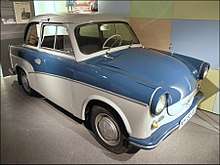
The Trabant P50 was introduced in Communist East Germany in 1957, followed shortly afterwards by the updated 601 in 1963. Because of its outdated and inefficient two-stroke engine (which produced poor fuel economy, low power output and thick, smoky exhaust), duroplast body and production shortages, the Trabant was regarded with derisive affection as a symbol of the economic downturn of East Germany and of the fall of the Eastern Bloc. Many East Germans streamed into West Berlin and West Germany in their Trabants after the opening of the Berlin Wall in 1989. However, the end of the GDR also meant the end of the Trabant as it wasn't competitive anymore against its new, much more sophisticated West German, French and Japanese competitors that quickly conquered the East German and Eastern European markets following the fall of the wall and the end of the Eastern Bloc. VEB Sachsenring, the manufacturer, tried to respond with an updated Trabant, the Trabant 1.1, that was first shown in 1989 and featured a new four-stroke engine by Volkswagen, but this proved too little too late to save the outdated car, and production lasted for only about two years. Time magazine named the Trabant one of the 50 worst cars of all time, and it was included in Automotive Atrocities! The Cars We Love to Hate with author Eric Peters describing its two-stroke, 18 horsepower engine as "Notorious for producing a billowing contrail of smoke, while its unsynchronized manual transmission required at least a fifth of Stolichnaya to deal with effectively."[10] Automotive journalist Dan Neil said the Trabant was the car "that gave communism a bad name" and was "a hollow lie of a car constructed of recycled worthlessness."[6] He also noted that after East Germans drove their Trabants to freedom in West Germany, they immediately abandoned them.[6] Edmunds.com ranked the Trabant as the 9th worst car of all time, claiming it is "one more reason why Communism is evil."[8] In his book "Crap Cars", Richard Porter ranked it the 9th worst car ever and said: "Before the old borders were broken down, us in the West thought we knew how harsh life was behind the Iron Curtain. Then we saw the Trabant. Oh, the humanity."[11] It was the butt of jokes in East Germany. After the end of the GDR, these jokes quickly spread to West Germany as well and also became a popcultural phenomenon when comedy films like Go Trabi Go and Trabbi goes to Hollywood featured Trabants as important plot devices. However, despite, and partly even because of its poor image, the Trabant has gained a strong cult following in the whole of reunified Germany, with many collectors clubs across the country maintaining them, and today it is considered a recognizable nostalgic symbol of the gone world of the GDR that, together with other products considered typical for East Germany, regained popularity since the reunification due to a phenomenon known as Ostalgie, a German term referring to nostalgia for aspects of life in East Germany.
Edsel (1958)
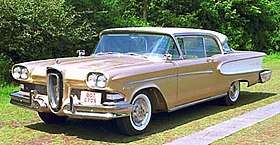
Launched with considerable publicity, the Edsel (named after Henry Ford's son) was the culmination of $400 million in investment and marketing by the Ford Motor Company to create a new brand of car positioned between the entry-level Ford and the medium-priced Mercury brand that was to compete against the General Motors brands Buick and Oldsmobile. Marketed as a radically different new car, the Edsel failed to impress the buying public – despite containing new features such as self-adjusting brakes and automatic lubrication, which would be adopted across the automotive industry – as it mainly consisted of Ford and Mercury components already used in other vehicles. It became such a large commercial failure that the name "Edsel" remains synonymous with "commercial failure" in American popular culture.[12] It was a big financial flop, generating losses estimated between $250 million and $350 million and bankrupting many Ford dealers.[13] Time magazine included it on its list of "The 50 Worst Cars of All Time", with automotive journalist Dan Neil writing that while the Edsel wasn't a bad car, "It was the first victim of Madison Avenue hyper-hype. Ford's marketing mavens had led the public to expect some plutonium-powered, pancake-making wondercar; what they got was a Mercury."[6] The Los Angeles Times included it on its list of the 10 worst cars sold in America, calling it a "redecorated Mercury that had been beaten with an ugly stick. The legendary flop of all automotive flops."[14] CNBC placed the Edsel on its list of the 10 ugliest cars of all time.[15] The Edsel's unique "horsecollar" grille has been frequently ridiculed for resembling a toilet seat, and later even the female genitalia.[6] Famous sarcastic descriptions of the Edsel and its famous grille include that it looked like "a Mercury pushing a toilet seat" or "an Oldsmobile sucking a lemon". The tail lamps were also criticized as looking like "ingrowing toenails".[13] However, contrary to popular belief, the controversial design of the grille was not the main reason for its failure. It mainly suffered from bad marketing, bad quality and being released at a time when the USA were hit by a recession and demand for medium-priced large cars decreased as US consumers started buying smaller economy cars, especially the Volkswagen Beetle.[13] For example, Chrysler phased out its similarly-positioned DeSoto brand in late 1960, about the same time as Ford discontinued the Edsel marque. Edmunds.com ranked the 1958 Edsel as the 7th worst car of all time.[8] However, in the book Automotive Atrocities! The Cars We Love to Hate, author Eric Peters declined to include the Edsel and defended it, saying, "People made fun of the Edsel – Ford's $400 million mistake – but its resemblance to a chrome-splattered bus station urinal aside, at least the Edsel worked. Though hideous, you could count on the mechanicals underneath the skin, which were solidly Ford and thus as good as any other car of the era."[10]
1960s
Chevrolet Corvair (1960–64)
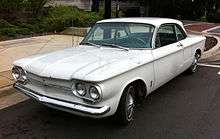
While the Chevrolet Corvair was popular and critically praised upon launch, it earned scrutiny for its rear-engined layout with a swing-axle rear suspension, which gave it different handling characteristics from other cars and caused a high number of highway accidents among drivers not used to the Corvair's unusual handling. Over 100 lawsuits were filed against General Motors in response, which resulted in consumer advocate Ralph Nader specifically scrutinizing the Corvair in his 1965 book Unsafe at Any Speed. This negative publicity was compounded by the revelation that GM declined to include suspension upgrades on the 1960-63 model years that would have given the Corvair safer handling for cost reasons.[6] These suspension upgrades were included in the 1964 model year, before Chevrolet completely redesigned the suspension with a fully independent setup when the second generation was released in 1965. However, GM's attempts to discredit Nader further brought negative publicity, at the same time that the Ford Mustang was putting significant strain on Corvair sales.[16] CNN included the Corvair on its list of "The Ten Most Questionable Cars of All Time",[16] and it was included on Time Magazine's "50 Worst Cars of All Time".[6] Former GM executive John DeLorean asserted in On a Clear Day You Can See General Motors (1979) that Nader's criticisms were valid.[17] Former Ford and Chrysler President Lee Iacocca said the Corvair was 'unsafe' and a 'terrible' car in his book, Iacocca: An Autobiography.[18] Dan Neil wrote, "Chevrolet execs knew the Corvair was a handful, but they declined to spend the few dollars per car to make the swing-axle rear suspension more manageable. Ohhh, they came to regret that."[6] The controversy around the Corvair eventually led to the founding of the National Highway Traffic Safety Administration as well as mandatory safety testing in the United States.[16] Ironically, two years after production on the Corvair ended, a NHTSA report studying the handling of 1960-63 Corvairs argued that a properly maintained Corvair handled comparably to its contemporaries.[19]Edmunds.com ranked the Corvair as the 62nd worst car of all time, stating that "Nader had a point."[8] The Truth About Cars-offshoot site Curbside Classic named the Corvair as one of the major "deadly sins" that led to GM's downfall; "The Corvair was the product of GM’s repeated tendencies to go off in directions that were an engineer’s dream, but were either flawed from the initial concept, or diminished by the bean counters. In the case of the Corvair, it was both."[20]
Hillman Imp (1963–76)
.jpg)
Despite being released with high hopes and getting much positive media attention at the time of its launch, the Hillman Imp was a commercial failure that was largely responsible for its parent group, the Rootes Group, getting into financial difficulties and being taken over by Chrysler to become part of Chrysler Europe in 1967. Designed as a small economy car that was to compete mainly with the Mini, it was at first hailed for its modern design, good road handling and innovations like a motor block made completely of aluminium and an opening rear window that, together with a folding backseat, allowed for decent luggage space. However, it was criticized for having rear engine and rear wheel drive layout while the Mini had paved the way for front engined, front wheel drive small cars. But the main problem that soon damaged its reputation became the low quality that was a result of the inexperienced Scottish workforce and poor quality control at the new, purpose-built Linwood plant as well as the underdeveloped design that was rushed into production within only about three years. Quality issues included frequent failure of gearboxes and water pumps, poor engine cooling that often resulted in motors overheating and generally low production quality and poor panel fit. As a result, the Imp never sold as well as planned, never even came close to the sales of the Mini and was largely responsible for the Rootes Group's financial losses that almost bankrupted the company and led to the takeover by Chrysler. The Imp was featured in the books "The Worst Cars Ever Sold" by Giles Chapman[2] and "Naff Motors: 101 Automotive Lemons" by Tony Davis,[3] was named among "The Five Worst English Cars of All Time" in a 2012 article on askaprice.com[21] and ranked the 5th worst British car in a 2008 survey of 4,000 motorists, carried out by internet magazine iMotormag.[22]
Subaru 360 (North American version) (1968–70)
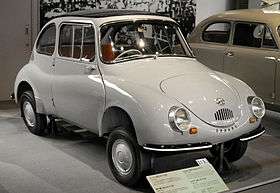
As the Subaru 360 was successful in its native country of Japan, in 1968 it was imported to America by entrepreneur Malcolm Bricklin, who found that he could import them for little cost because they were light enough to be exempt from US automotive safety standards. The first Subaru model sold in America, the 360 had a MSRP of $1,297 and was marketed with the slogan "Cheap and ugly does it!" [23] The 360 ended up being a critically panned commercial failure in North America. Car and Driver, in a period review, called it one of the ugliest cars in history and "the most bulbous bubble ever to putt-putt."[23] The 360 was panned by Consumer Reports, which rated it "not acceptable" and remains one of the worst vehicles the publication has ever tested.[23] Consumer Reports noted that the 360 took 37.5 seconds to go from 0-60 MPH, it proved to be dangerously structurally deficient in a 30MPH crash test with a standard car and its bumpers were "virtually useless against anything more formidable than a watermelon", all of which made the publication deem the 360 to be "unacceptably hazardous".[23] They ended the review by saying that it "was a pleasure to squirm out of the [car], slam the door and walk away."[23] 360s remained unsold in stock for years, leading Bricklin to attempt to launch a series of Go Kart race tracks using the Subarus as racing cars. Urban legends persist that unsold 360s were either crushed or pushed into the ocean. Imports of the vehicle ceased in 1970 and despite the 360's failure, Subaru of America continued operation and eventually found success, selling over 200,000 units a year by 2006.[23]
1970s
AMC Gremlin (1970–78)
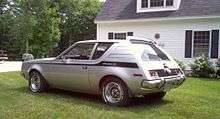
The 1970 AMC Gremlin, a shortened version of the AMC Hornet, was introduced for 1970 as an entry to compete in the emerging market for compact cars. However, its odd styling and out-of-date technology has earned it lasting derision. Named by Time magazine as one of the 50 worst cars of all time, Dan Neil wrote that "[Richard] Teague's design team basically whacked off the rear of the AMC Hornet with a cleaver. The result was one of the most curiously proportioned cars ever [...] Cheap and incredibly deprived — with vacuum-operated windshield wipers, no less — the Gremlin was also awful to drive, with a heavy six-cylinder motor and choppy, unhappy handling due to the loss of suspension travel in the back. The Gremlin was quicker than other subcompacts but, alas, that only meant you heard the jeers and laughter that much sooner."[6] Included on CNN's list of "The Ten Most Questionable Cars of All Time", it said of the Gremlin, "Like other AMC cars (see the Pacer) the Gremlin can be seen as either a daring leap forward by an innovative underdog or as a desperate attempt to do something - anything - that would stand out in a marketplace dominated by larger competitors."[16] The Gremlin also placed 4th on Car Talk's "Worst Car of the Millennium" poll, and named by CNBC on its list of the ten ugliest cars of all time.[15] Including it in his book Automotive Atrocities! The Cars We Love to Hate, author Eric Peters wrote that the Gremlin had a "distinctive 'What happened to the rest of your car, buddy?' look that became the Gremlin's signature design feature." He also said that the 1970 Gremlin's lack of disc brakes, radial tires and electronic windshield wipers "hearkened back to the technologically sophisticated days of 1935."[10] Edmunds.com ranked the Gremlin as the 19th worst car of all time, saying, "it runs second only to its brother the Pacer in Loserland."[8]
Chevrolet Vega (1971–77)
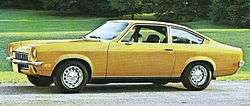
While the Chevrolet Vega earned critical acclaim upon launch, was named the Motor Trend Car of the Year for 1971 and became a best seller, its reputation would be permanently damaged upon the revelation of severe quality and reliability issues. While its aluminum block engine and new method of rustproofing were initially praised as innovative, the Vega was proven to have an extreme vulnerability to corrosion and premature engine failure. By the late 1970s, Vegas were being scrapped at such a high rate that many junkyards refused to purchase them.[24] Autoblog included the Vega on its list "The 20 Dumbest Cars of All Time", saying that it "proved the point that American car makers did not make good small cars."[5] It placed 2nd on Car Talk's poll of "The Worst Car of the Millennium," was named on Forbes' 2004 list of "The Worst Cars of All Time" and named by Car and Driver one of the 10 most embarrassing award-winning cars, stating, "The Chevy Vega is on everyone's short list for Worst Car of All Time. It seemed the only time anyone saw a Vega on the road not puking out oily smoke was when it was being towed."[25] Popular Mechanics named the Vega on their list "10 Cars That Damaged GM's Reputation"[26] and later commemorated the 40th anniversary of its launch, marking the Vega as the catalyst that put General Motors on the downward spiral which culminated in its bankruptcy in 2009.[24] The 2010 retrospective also took note of the Vega's high sales numbers in relation to its poor quality, noting, "Since the Vega sold so strongly (almost 2 million were built before it left production after 1977), the result was that literally hundreds of thousands of buyers were having awful experiences with the car. [...] Surely, those customers were then far more willing to consider the Japanese alternatives that were starting to arrive."[24] The Truth About Cars named the Vega as one of the "deadly sins" that led to GM's downfall, "The Vega was GM's Watergate/Waterloo, the beginning of the inevitable end."[27] Edmunds.com ranked the Vega as the 5th worst car of all time.[8] In his 1979 book On a Clear Day You Can See General Motors, former GM executive John DeLorean devoted an entire chapter to the Vega, describing how the Vega did poorly in durability testing and that GM knew about its quality problems prior to launch.[17]
Ford Pinto (1971–80)
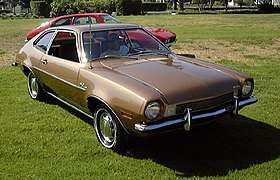
While the Ford Pinto was a strong seller that got a decent reception, its reputation was permanently marred upon the discovery that the car could catch fire upon being rear ended due to a defective fuel tank design, as well as the revelation of the infamous "Pinto memo", which revealed that Ford executives knew about the design defect and decided to do nothing after calculating that paying off lawsuits was cheaper than re-engineering the car. Including the car in his book Automotive Atrocities! The Cars We Love to Hate, Eric Peters discussed the "Pinto memo", noted that it would have cost Ford $1 per car to reinforce the fuel tank, and summed up the Pinto's entry with the line, "See how much corporate America cares?"[10] Included on Time magazine's list of the 50 worst cars of all time, Dan Neil wrote of its inclusion, "They shoot horses, don’t they? Well, this is fish in a barrel. Of course the Pinto goes on the Worst list, but not because it was a particularly bad car — not particularly — but because it had a rather volatile nature. The car tended to erupt in flame in rear-end collisions."[6] Named one of the "Most Questionable Cars of All Time", CNN said of it, "Images of flaming Pintos are so seared into the public consciousness that it's probably hard for most people, unaided by a photograph, to conjure a mental image of the car while not on fire."[16] Autoblog ranked the Pinto #1 on its list "The 20 Dumbest Cars of All Time", taking note of the combination of the Pinto's dangerous defect with how Ford marketed it towards young drivers: "So, this car was aimed at the least experienced drivers in America and the most prone to being in accidents. And after the truth came out, it soured a lot of those kids and their parents on buying more Fords just as the Asians were rising and redefining quality in America."[5] Aside from the fire issues, the Pinto was also criticized for its poor name choice. It was named after the pinto horse, but "Pinto" is slang for the male genitalia in Portuguese, resulting in poor sales on the Brazilian market. International Business Times included the Pinto in a list of The 5 Worst Name Oversights.[28] The Pinto placed third in Car Talk's 2000 "Worst Car of the Millennium" survey[7] and was ranked the 16th worst car of all time by Edmunds.com.[8]
Morris Marina (1972–80)

From its release, the Morris Marina has been criticised for its poor performance, styling, handling and build quality. It was also considered outdated at the time of its launch as its technical layout was largely based on the Morris Minor whose development started in the 1940s. The Telegraph included the Marina on its list of "10 Cars That Should Have Never Been Produced".[29] British motoring journalist Jeremy Clarkson has criticised the Morris Marina on several television programmes: In Clarkson's Car Years, originally broadcast in 2000, he compared the Marina to the Austin Allegro to determine which one was worse, and he destroyed a Marina in an automotive game of Conkers on one of his DVDs. Clarkson has said of the Marina that "It cost 40 million pounds to develop, which since it was meant to be hopeless, was too much," and that its rear suspension "dates back to a medieval hand cart." Destroying Marinas has become a running gag on the BBC series Top Gear, which has drawn the ire of Marina enthusiasts and resulted in complaints been made to the BBC. In addressing the complaints, Top Gear presenter James May has stated that at least one Marina needs to be preserved in a museum as "a warning from history". CarThrottle ranked it #1 on it's list of "10 Of The Worst Cars Ever Made In The UK".[30]
Reliant Robin/Rialto (1973–2002)
.jpg)
The Reliant Robin is a three-wheeled small car. It is the perhaps best-known and most infamous product of the British three-wheeled car industry that was very successful from the 1950s until the 1980s; mainly due to British tax loopholes that allowed three-wheeled cars to be taxed as motorcycles and be driven with a motorcycle licence. The Robin enjoyed sales success throughout its lifetime and has a special place in British culture. Its name was so popular that its 1982 successor, the Reliant Rialto, was renamed Robin again in 1989, thus making the Robin name live on for another thirteen years and even making it see the new millennium until production finally came to a halt in 2002. But despite its success, it has also become the butt of many jokes due to its three-wheeled nature, fibreglass bodyshell and primitive, old-fashioned technique and is often cited among the worst cars ever made. It is sometimes affectionately nicknamed the "Plastic Pig" because of it's distinctive shape and fibreglass body shell. It was also part of a famous episode of Top Gear (series 15, episode 1), in which Jeremy Clarkson drives a Reliant Robin and makes it roll over multiple times. He described driving it as dangerous as "inviting your mum 'round for an evening on chatroulette", and that the Robin "wasn't funny, it was a complete menace." The following two episodes featured racing driver The Stig and Ken Block on their test track in Robins, and neither of them could finish a clean lap in the specially doctored Robin. Later on, Clarkson admitted that the Robin used in the show had the differential modified to allow it to roll over easily. He also admitted that he actually likes the Robin.[31] The Robin was featured in the books "The Worst Cars Ever Sold" by Giles Chapman[2] and "Crap Cars" by Richard Porter.[11] It was voted the 8th worst car ever in an Auto Express poll, with the article saying "The butt of countless jokes, the Reliant Robin was missing more than a wheel and will be remember[sic!] as one of the worst cars ever".[32] In a 2013 poll, it was voted the worst British car of all time.[33] Edmunds.com ranked it the 13th worst car of all time, stating "Ludicrously unstable three-wheeler that turns turtle on its plastic body at the slightest provocation. Fortunately, with a 750cc engine, it was underpowered, too."[8] CarThrottle ranked it number two on its list of "10 Of The Worst Cars Ever Made In The UK".[30]
Austin Allegro (1974–82)
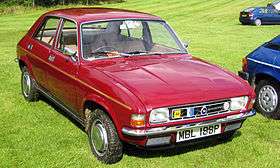
The Austin Allegro was launched in 1973, intended to be a radical clean sheet design by British Leyland. However, it has been strongly criticized since its reputation for its poor quality and odd styling. In his book Crap Cars, writer Richard Porter says "the only bit of the Allegro they got even vaguely right was the rust-proofing". The Allegro was placed second worst in his list, beaten only by the VW Beetle.[34] The poor reputation of the car and the inefficient production and management techniques in British Leyland at the time at which it was produced have meant that the Austin Allegro has become associated with waste, inefficiency and poor quality. In Clarkson's Car Years Jeremy Clarkson compares the Austin Allegro to the Morris Marina. He concludes the Allegro was a better (less bad) car than the Marina, because the Allegro was a horrible car in a more original way than the Marina. Clarkson further said of the Allegro that it was "hideously ugly", whoever proposed its square steering wheel should have had pens thrown at him, and that "it was more aerodynamic going backwards." In 2007, Sir Digby Jones, in criticising the inefficiencies of the Learning and Skills Council, said, "It is what I call 'the British Leyland model' – you put a lot of money in at the top, and an Austin Allegro comes out at the bottom".[35] Edmunds.com ranked the Allegro as the 81st worst car of all time, and expressed gratitude that it was never exported to the United States.[8]
Ford Mustang II (1974–78)
.jpg)
While the Ford Mustang II was well received by both critics and consumers upon its launch, today it is strongly criticized for being a poor-performing Pinto derivative, even though its good fuel economy made it popular after the 1973 oil crisis. Car and Driver listed the Mustang II as one of the 10 most embarrassing award winners, stating, "Instead of the powerful car the Mustang had been, here was a poseur with wheezing four- and six-cylinder engines under the hood. And except for better fuel economy, there were no compensating virtues."[25] Autoblog named the Mustang II as one of the "20 Dumbest Cars of All Time" and claimed that for it to have been named the 1974 Motor Trend Car of the Year, "Motor Trend, back in the day, had to be trading annual honors for ad pages."[5] Eric Peters wrote of the Mustang II in his book Automotive Atrocities! The Cars We Love to Hate, "Reeling, wild-eyed and increasingly desperate [in the wake of the 1973 oil crisis and new emission requirements from the EPA], Ford belched up the Pinto-sourced, "downsized" Mustang II – a car with all the kick of a watered-down Shirley Temple."[10] Edmunds.com ranked the Mustang II as the 2nd worst car of all time, describing it as "instantly appalling to Mustang lovers."[8]
AMC Pacer (1975–80)

Intended to be a radical new concept, as well as being the first automobile to use cab forward design, the AMC Pacer's odd styling has also been criticized. A 2007 survey conducted of its clients by the Hagerty Insurance Agency named the Pacer the worst car design of all time.[6] including it in Time magazine's "50 Worst Cars of All Time", Dan Neil described the Pacer as a "glassine bolus of dorkiness" and that "in the summer, it was like being an ant under a mean kid’s magnifying glass. The air conditioning was non-existent. You could actually see fumes of volatile petrochemicals out-gassing from the plastic dash."[6] CNN named the Pacer as one of "The 10 Most Questionable Cars of All Time"; "The bulbous, blobby Pacer is remembered today as the ultimate example of 'the nerdy car my parents drove.' (Its starring role in the 1992 geeksploitation flick Wayne's World didn't help.)"[16] It is included in the book Automotive Atrocities! The Cars We Love to Hate, which prominently features the Pacer on the cover. Its entry says the Pacer "defined the 1970s even more than a Bee Gees 8-track, the "Farrah" hairstyle, or the leisure suit. In fact, wearing a leisure suit and listening to a Bee Gees 8 track while driving to your job as assistant manager at the local McDonald's was perhaps the ultimate 1970s experience."[10] It also took note of the Pacer's newfound collector status as a piece of kitsch, saying, "As a car, it isn't much - but as a conversation piece, it's almost as good as having a restored Elvis: Alive! pinball machine in your den."[10] Edmunds.com ranked the Pacer as the 20th worst car of all time, describing it as "an icon of disenfranchised losers."[8] The Pacer has also been notably lampooned in the 1992 film Wayne's World.
Bricklin SV-1 (1975)

The Bricklin SV-1 was brought to life by automotive entrepreneur Malcolm Bricklin, who funded development and production of the car from the government of the Canadian province of New Brunswick. Production stopped in early 1976 when the company went into receivership. Including the Bricklin on its list of "The 20 Dumbest Cars of All Time", Autoblog wrote, "Memo to the world: When an automobile executive starts a new car company and proposes to name the car after himself, run like a stag in the opposite direction, lock your check book and credit cards in a safe and ask your best friend to keep the combination away from you no matter how much you beg for it. This scenario never turns out well."[5] Including it in his book Automotive Atrocities! The Cars We Love to Hate, Eric Peters acknowledged the numerous safety features the Bricklin helped to pioneer before writing, "In theory, it all sounded fabulous. ... But the SV1 was basically a kit car cobbled together using mish-mashed leftovers acquired from Ford and American Motors. Lack of money and technical and engineering resources was evident in the way the car was put together. It had the look and feel of a teenage hot rod project built in the backyard with a Sawzall and some RTV."[10] It was named one of the 50 worst cars of all time by Time magazine, with Dan Neil saying of it, "The SV1 was supposed to exemplify the safer car of the future; the name stands for “Safety Vehicle 1.” The bodies were made of brightly colored, dent-resistant plastic, like PlaySkool furniture. Another safety feature: incredible, crust-of-the-Earth-cooling slowness. All those resin panels and compressible bumpers added hundreds of pounds that the emissions-limited V8s couldn’t handle. This thing couldn’t outrun the Rose Bowl Parade."[6] Edmunds.com ranked the Bricklin as the 72nd worst car of all time, claiming it "makes the DeLorean look like an engineering magnum opus."[8]
Triumph TR7 (1975–81)
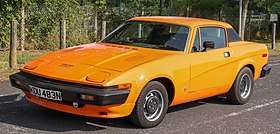
The Triumph TR7 was one of the last models produced by Triumph before its demise in 1984. The TR7 was widely criticized and ridiculed for its styling, especially the strange curve in the side. A popular urban legend states that upon its debut, legendary Italian auto designer Giorgetto Giugiaro examined a TR7 at an auto show, walked around to the other side of the car and exclaimed, "Oh my god – they did it to the other side, too!" Quality problems tended to undermine the car's image in the market place. This was primarily the result of the poor relations between management and workforce and frequent strikes at the Speke factory near Liverpool.[36] Furthermore, the TR7 was designed to be a roadster, but at first was only available with a permanent roof as proposed new rollover safety regulations in the USA, its intended main market, threatened to effectively ban the sale of convertibles. However, this did not happen, so a convertible version became available in 1979. Quality also improved when production was moved to the Canley plant in Coventry, and later Solihull, but it was too late to save the car's already damaged reputation. In its Frankfurt Motor Show preview edition of September 1977, the German magazine Auto, Motor und Sport reported that the engine of a TR7 press car had broken down and "started to boil" while undergoing a maximum speed measurement exercise over a 4 km (2.5 miles) stretch of track as part of a road test.[37] It was included on Time magazine's list of the 50 worst cars of all time; automotive journalist Dan Neil wrote that the main issue with the TR7 was that "the cars were so horribly made. The thing had more short-circuits than a mixing board with a bong spilled on it."[38] Jeremy Clarkson criticized the TR7 and destroyed one in his DVD special Heaven and Hell. Edmunds.com ranked the TR7 as the 47th worst car of all time.[8]
Chevrolet Chevette (1976–87)
The Chevrolet Chevette has commonly been criticized for its poor performance, poor build quality and general cheap feel. It has been included in Time magazine's list of the 50 worst cars of all time, it placed 5th in Car Talk's poll "Worst Car of the Millennium,"[7] and is included in the book Automotive Atrocities! The Cars We Love to Hate by Eric Peters. In its inclusion, Peters poked fun at the Chevette's name, suggesting, "Owners of Chevy's austere little econobox could also casually mention their "'Vette" parked outside to comely (if gullible) prospects at singles bars – though it was critical that said prospects consume a minimum of three double-strong Long Island Iced Teas before suggesting a ride back to your parents' basement."[10] CNN included it on its list of the "10 Most Questionable Cars of All Time" – where it was described as "Pathetic". CNN expanded describing the Chevette as, "Another GM attempt to compete against small, inexpensive imports. And, again, this one wasn't a market flop. In fact, the Chevette was the best-selling small car in America for the 1979 and 1980 model years. Ultimately, 2.7 million were produced over its lifetime. But it is remembered today for being mechanically troubled, poorly constructed and underpowered, a sad reminder of the trouble Detroit automakers had (and still have) in responding to the flood of small, cheap cars from Japan."[16] Popular Mechanics named the Chevette on their list "10 Cars that Damaged GM's Reputation" due to it being utilized as GM's response to advanced, front wheel drive subcompacts such as the Volkswagen Rabbit and Honda Civic despite its poor performance, technologically crude rear wheel drive platform and poorly packaged interior: "it was always a car that sold strictly on price, with no real virtues of its own."[26] Popular Mechanics also noted how the Chevette's success and long production run allowed GM to not develop a proper front wheel drive subcompact, instead utilizing a series of badge engineered captive imports from Suzuki, Isuzu and Daewoo to serve as Chevrolet's entry level models after Chevette production ended, something they described as "one of the company's greatest missteps of all."[26] Edmunds.com listed the Chevette as the 53rd worst car of all time.[8]
FSO Polonez (1978–2002)
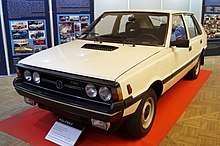
The FSO Polonez was largely based on the Polski Fiat 125p that had already been manufactured in Poland by FSO since 1967, but featured a completely new hatchback body designed by Giugiaro. It was rather ambitious for its time, being the first Polish-built car to feature a hatchback body and the first mass-produced Polish car to have its own design, but it was largely panned in most markets outside Eastern Europe due to its poor quality, poor design and poor performance. Jeremy Clarkson said about the Polonez: "Built by communists out of steel so thin you could use it as a net curtain, it is as reliable and long lasting as a pensioner's erection",[39] "Of course history has served up many cars that drove as badly as this, but few looked quite so terrible"[40] and "Its[sic!] did have a redeeming feature - it was cheap. But it had to be, because it was a car that wasn’t really a car at all. It was a box under which the careless car buyer would discover a ’40s tractor."[41] It was also featured in a Top Gear episode titled "The Worst Car In The History Of The World" in which Clarkson is seen driving a Polonez on a country road where it breaks down twice.[40] TheStreet.com ranked it 6th in its list of the 20 Worst Cars of All Time,[39] and it was voted the 9th worst car of all time in a poll by Auto Express.[42]
1980s
Chevrolet Corvette 305 "California" (1980)
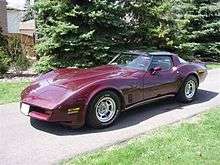
Emission requirements in the US state of California, which are frequently stricter than those in the rest of the country, required that all Corvettes sold there during the 1980 model year be fitted with a 180-horsepower 305 cu. in. "smallblock" V8 engine with a 3-speed automatic transmission. This model of Corvette is particularly derided for its poor performance. Edmunds.com named this model the 3rd worst Corvette of all time,[43] Time Magazine listed it as one of the 50 worst cars of all time, and it is included in Automotive Atrocities! The Cars We Love to Hate by Eric Peters. Dan Neil wrote of the 1980 small block Corvette, "[California state regs] required that the barely adequate 350 cu in (5.7 L) smallblock in the 1980 Corvette be replaced with a wholly inadequate 305 V8, putting out 180 hp of pure shame. On top of that, the "California" Corvette sucked its pitiful rivulet of horsepower through the straw of a torque-sapping three-speed automatic transmission. ... These were dark days indeed."[44] Eric Peters noted in the 305 Corvette's Automotive Atrocities entry that it is today rejected by enthusiasts, not mentioned in official histories and collector guides note buyers to avoid this model as it will never appreciate significantly in value.[10]
General Motors X platform compact cars (1980–85)

When the Chevrolet Citation, also sold as the Pontiac Phoenix, Oldsmobile Omega and Buick Skylark was introduced in early 1979, it received a strongly positive response: the Citation was the 1980 Motor Trend Car of the Year and sold more than 800,000 units in its first year. However, it received scrutiny for numerous safety and quality issues, which led to a record number of recalls and a sales collapse.[45] Car and Driver named the Citation one of the most embarrassing award winners in history due to its numerous build quality and safety issues: "Things started going terribly wrong as soon as the X-car got in the hands of consumers. While staring down 60-month payment books, Citation owners were having trim bits fall off in their hands, hearing their transmissions groan and seize, and finding that if they listened closely enough they could hear their cars rust. [...] As GM's first front-drive compacts, the X-cars were significant vehicles: They slaughtered GM's reputation for a whole generation."[25] Car and Driver and several other car magazines at the time were duped when GM lent them specially modified versions of the X-body vehicles in which heavy torque steer (for which they became infamous) had been engineered out. Patrick Bedard of Car and Driver said that they were completely surprised by this when they drove a random production version acquired from a car rental company some time later.[46] Popular Mechanics named the X platform cars on their list "10 Cars that Damaged GM's Reputation" as they "promised a revolution in how the corporation designed and built cars[...]unfortunately, the reality was that these four- and six-cylinder cars probably suffered more recalls and endemic problems than any other GM vehicle program." They also noted how successful the cars initially were on the marketplace, which "sour[ed] hundreds of thousands on GM."[26] The Truth About Cars similarly named the Citation as one of the major "deadly sins" that led to GM's downfall; "Typical for GM, the Citation looked best on paper, or to the automotive writers who were suckered when they drive the most un-production-like 'ringers' ever hand assembled and wrote breathless reports on the Citation’s spectacular 'better than a BMW' abilities. The current issue of C/D has a brief mea-culpa by Patrick Bedard about how they fell for GM’s bait [...] General build quality varied greatly, somewhere between miserable and mediocre. Cost cutting resulted in skin cutting from rough edges. Within one model year, the word was out and the jig was up: the Citation was a lemon."[45] Edmunds.com ranked the Citation as 52nd worst car of all time.[8]
Cadillac V8-6-4 (1981)
.jpg)
For the 1981 model year only, Cadillac offered a feature on its V8 engine called the V8-6-4. On this engine, up to four cylinders could be deactivated while cruising to save fuel. However, the system suffered from numerous drivability issues as the computer technology at the time couldn't deactivate/reactivate the cylinders fast enough.[10] Many owners got fed up with the engine's poor performance and had the system disabled by mechanics.[6] Including the engine in Automotive Atrocities! The Cars We Love to Hate, Eric Peters called the V8-6-4 "one of the best ideas gone horribly wrong to ever reach production" and it was "the last thing a by-now-reeling Cadillac needed on top of the still-festering diesel imbroglio."[10] The V8-6-4 is also included on Time magazine's "50 Worst Cars of All Time", where Dan Neil described it as the "Titanic of engine programs". He continued, "The cars jerked, bucked, stalled, made rude noises and generally misbehaved until wild-eyed owners took the cars to have the system disconnected. For some it was the last time they ever saw the inside of a Cadillac dealership."[6] Popular Mechanics included the V8-6-4 Cadillacs on its list "10 Cars that Damaged GM's Reputation", describing it as "one more half-developed, cynically marketed technology that GM just couldn't make work."[26] Today, cylinder deactivation systems are a common feature on large-engined automobiles, including many produced by General Motors.
DeLorean DMC-12 (1981–83)

Despite the popular following the DeLorean DMC-12 has as a result of being featured in the popular 1985 sci-fi film Back to the Future, it was a commercial failure when first introduced and was critically derided. It was built in a new, purpose-built factory in Dunmurry, a suburb of Belfast, Northern Ireland, UK in order to improve the tense socioeconomic situation there (The Belfast region was one of the poorest in Western Europe due to the ongoing Northern Ireland conflict) and was largely funded by the UK Government which backed up the project with £55,000,000. But due to the inexperience of the Northern Irish workforce and the underdeveloped design, the car suffered from bad quality and disappointing performance. Even hiring Lotus founder Colin Chapman to help improve the vehicle did not help. Furthermore, the DMC-12 was overpriced and got released at a time when the United States, its target market, were badly hit by a recession that decreased the demand for expensive supercars. Including the DeLorean in Automotive Atrocities! The Cars We Love to Hate, Eric Peters stated, "If the DMC-12 had offered exotic-level performance to go with its exotic-level price, things might have been different. But as it turned out, the DMC-12 wasn't even competitive as a performance car with the run-of-the-mill six-cylinder Camaros, Firebirds and Mustangs of the era.", while noting that a DMC-12 was significantly more expensive than a 1981 Chevrolet Corvette.[10] In his book Naff Motors: 101 Automotive Lemons, Tony Davis described the build quality as "woeful".[3] Top Gear writer Richard Porter included it in his book Crap Cars, calling it "dismal",[11] while it was also included on Time magazine's list of the 50 worst cars of all time; Dan Neil said of it, "By the time Johnny Z. got the factory in Northern Ireland up and running — and what could possibly go wrong there? — the losses were piling up fast. The car was heavy, underpowered (the 2.8-liter Peugeot V6 never had a chance) and overpriced."[6]
Maserati Biturbo (1981–94)
.jpg)
The Maserati Biturbo has earned a negative reception for numerous reliability problems. Including it in Time magazine's list "The 50 Worst Cars of All Time", Dan Neil wrote, "Everything that could leak, burn, snap or rupture did so with the regularity of the Anvil Chorus. The collected service advisories would look like the Gutenberg Bible."[6] In the August 1990 issue of Road & Track, it was noted of the Biturbo's reliability, "Mis-set carburetor float levels caused the engine to stumble during left turns, pick-up wires in the distributor cracked from the heat, water ran through cylinder sleeves, fluids leaked from faulty seals throughout the drivetrain, fuse boxes melted, and coolant temperature warning lights came on even when the engines weren't overheating."[10] Including the Biturbo in Automotive Atrocities! The Cars We Love to Hate, Eric Peters wrote that the Biturbo "would viciously nickel-and-dime its owner to death with 'little things' that would drive all but those truly devoted to its survival into the toolbox for a large ball peen hammer."[10] In Crap Cars, Richard Porter slammed the Biturbo for "build quality best described as 'approximate'" and styling that "looks like a child's drawing of a car."[11] In an episode of Top Gear, Jeremy Clarkson expresses disdain for the Biturbo before destroying one by dropping a dumpster on it. Edmunds.com ranked it the 55th worst car of all time.[8]
Renault Fuego (North American version) (1982–84)
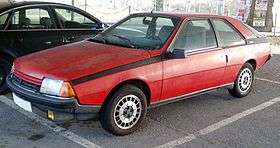
The North American Renault Fuego sports coupe has earned negative retroactive recognition, mainly for its numerous major reliability problems. Car and Driver retroactively described the Fuego as being "shaped like a walrus with gas.”[47] Hemmings Motor News wrote of how "The Fuego soon developed a reputation for unreliable electronics and overheating issues, which led to head gasket failures if ignored for any length of time. The problem was likely compounded by a poor spare parts availability, a situation that only worsened after Renault’s departure from the U.S. in 1986."[47] Included in the book Automotive Atrocities: The Cars We Love to Hate, author Eric Peters made note of Fuego's poor performance and poor reliability combined with difficulty in sourcing replacement parts and finding a mechanic that knew how to service a Renault, leading to rapid depreciation that reduced Fuegos to being completely worthless when they were still just a couple years old; "The ad copy said the Fuego boasted 'racy good looks that can up the pulse rate on sight,' though it may have more accurately described the heart flutters induced by the Fuego's frighteningly rapid depreciation rates. Running examples are almost worthless today - if, that is, you can find one that's still running."[10] The Fuego was also listed in Richard Porter's book Crap Cars. Edmunds.com ranked the North American Fuego as the 17th worst car of all time, describing it as a "Fragile, front-drive French coupe that rusted quickly into dust or burst into flames amid random electrical fires" and noted that it was "recalled for steering wheels that came off in drivers' hands."[8]
Cadillac Cimarron (1982–88)
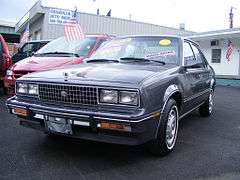
The Cadillac Cimarron was a hasty attempt for Cadillac to compete with smaller European luxury cars from manufacturers such as Mercedes-Benz and BMW. Facing time constraints, Cadillac simply marketed a fully equipped Chevrolet Cavalier with upmarket trim for twice the price of its other J body siblings. The Cimarron was included in Time magazine's list of "The 50 Worst Cars of All Time," was named the 8th worst car of the Millennium by Car Talk, placed 4th on Autoblog's list of "The 20 Dumbest Cars of All Time," and is included in the books Automotive Atrocities! The Cars We Love to Hate by Eric Peters and Crap Cars by Richard Porter. Automotive critic Dan Neil said of the Cimarron, "Everything that was wrong, venal, lazy and mendacious about GM in the 1980s was crystallized in this flagrant insult to the good name and fine customers of Cadillac. ... This bit of temporizing nearly killed Cadillac and remains its biggest shame."[48] Autoblog wrote, "It was a re-badged Chevy – a bad Chevy at that – and everyone knew it. Engineers at GM who were ordered to carry out the brief hated working on it. A few, we are told, even took early retirement to get out of it."[5] In Automotive Atrocities, Eric Peters wrote, "In the 1920s and 1930s, Cadillac was a respected peer of Bugatti and Rolls-Royce, the 'standard of the world' among luxury cars. By 1982, GM's premiere division had reduced itself to pawning off tarted-up Chevrolet Cavaliers, hoping no one would notice – at least until after the buyer's check cleared."[10] Forbes placed the Cimarron on its list of "Legendary Car Flops," citing low sales, poor performance and the fact the car "didn't work, coming from a luxury brand."[49] CNN Money described the Cimarron as "in all important respects, a Chevrolet Cavalier. It also added thousands to the price tag. In all, it was neither a good Cadillac nor a good value. Today, GM executives will readily admit that this was a bad idea."[50] Car and Driver said a subsequent Cadillac product director kept a picture of the Cimarron on his wall captioned, "Lest we forget."[51] Popular Mechanics named the Cimarron as one of the 10 cars that damaged GM's reputation, describing GM's attempt to market the Cimarron as a domestic alternative to the BMW 3 Series as "pathetic": "There's nothing wrong with the idea of a smaller, more athletic Cadillac. But it was a terrible idea to rebadge the Chevrolet Cavalier and attempt to pawn it off as a true Cadillac.[...]Not surprisingly, practically no one fell for it and the Cimarron never sold well."[26] The Truth About Cars named the Cimarron as one of the "deadly sins" that led to GM's downfall; author Paul Niedermeyer wrote of it, "Yes, as if there was ever any doubt, GM truly jumped the shark with the Cimarron, and it led the way for what was GM’s most disastrous decade ever, the eighties. Only GM could have such utterly outsized hubris to think it could get away with dressing up a Cavalier and pawning it off as a BMW-fighter, without even touching the engine, among other sins [...] the Cimarron was a dud, from the get-go. GM managed to fool some 25k buyers the first year, but sales steadily drooped thereafter. The damage it did to the Cadillac brand was incalculable. But the Cimarron was just one of many wounds of the ritual suicide Cadillac was putting itself through during those dark days."[52] Edmunds.com ranked the Cimarron as the 8th worst car of all time.[8]
Chevrolet Camaro equipped with the Iron Duke engine (1982–85)

For 1982, the redesigned Chevrolet Camaro offered the 90 hp Iron Duke 4 cylinder engine with a 3-speed automatic transmission as its standard powertrain – something that was strongly derided in such a car with a high-performance reputation. Autoweek, describing this model as the slowest Camaro ever sold, noted that a Camaro with this powertrain had the same power-to-weight ratio as the Volkswagen Beetle and that the Chevrolet Chevette Scooter had a slightly better ratio.[53] This variant of the Camaro was included in Time magazine's list of "The 50 Worst Cars of All Time"; Dan Neil said of it, "As the base engine for the redesigned 1982 Camaro (and Pontiac Firebird), the 2.5-liter, four-cylinder “Iron Duke” was the smallest, least powerful, most un-Camaro-like engine that could be and, like the California Corvette, it was connected to a low-tech three-speed slushbox. So equipped, the Iron Duke Camaro had 0-60 mph acceleration of around 20 seconds, which left Camaro owners to drum their fingers while school buses rocketed past in a blur of yellow."[6] Including this car in Automotive Atrocities! The Cars We Love to Hate, Eric Peters wrote that the Iron Duke equipped Camaro gave owners "the humiliation of being left in the dust by K-car station wagons."[10] This model of the Camaro was ranked the 61st worst car of all time by Edmunds.com.[8] This engine was dropped for 1986.
Renault Alliance (1983–87)
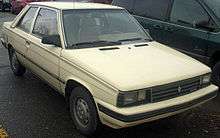
Introduced for 1983, the Renault Alliance was a compact car co-developed by French automaker Renault and American Motors for sale in the United States. While initial sales were strong and the car earned critical acclaim, retroactive reviews of the Alliance are strongly negative. Car and Driver included the Alliance on its list of "The 10 Most Embarrassing Award Winners in History", using the piece to apologize for placing the Alliance on their 10 Best list in 1983 and continued by writing, "The Alliance proved that Wisconsin workers could assemble a Renault with the same indifference to quality that was a hallmark of the French automotive industry. By the late '80s, the sight of rusted Alliances abandoned alongside America's roads was so common that their resale value had dropped to nearly zero."[25] The Alliance is included twice in Automotive Atrocities! The Cars We Love to Hate, with author Eric Peters giving the Alliance and its high-performance GTA variant separate entries. Peters described the Alliance as a "K-car wannabe" and said of its joint development with Renault, "Not since Thomas Jefferson's Louisiana Purchase. ... had the French agreed to such an ill-conceived deal."[10] Edmunds.com ranked the Alliance as the 12th worst car of all time.[8]
Alfa Romeo Arna (1984–87)
The Alfa Romeo Arna, the product of a joint venture between Alfa Romeo and Nissan, showed promise in development. However, the finished product was merely a rebadged Nissan Cherry hatchback retrofitted with Alfa components and manufactured in Italy. The combination of the generic styling and poor handling common to Japanese cars of the time with the poor build quality and reliability Alfa was notorious for was seen as combining the worst qualities of both companies.[54] In a 2000 episode of Clarkson's Car Years, Jeremy Clarkson described the Arna as being a "truly horrific cross-breed" and "one of the worst creations in the whole of history"; "It might have worked had they married Japanese build quality with Italian design flair, but they did it the other way around! So what we ended up with was a terribly ugly Nissan Cherry with Alfasud electrics! Can you imagine anything, anything worse?"[55] MSN Autos named it #1 on their list of "Top 10 Disastrous Cars"; "A mix of Italian flair and Japanese expertise should have been made in heaven, but they clearly decided to divide the tasks by means of a lucky dip. Alfa ended up doing the electronics while Nissan took care of the styling, resulting in an ugly car that didn’t work properly."[54] Car magazine ranked the Arna as one of the worst cars of the past 50 years, writing, "Nissan donated its unlovely Cherry body panels while the Italians lent their exceptionally unexceptional electrical and construction expertise. Result: the most ‘bello’ Alfa ever."[56] As of March 2018 only three Arnas are shown to still exist in the United Kingdom, all three of them being SORNs.[57]
Pontiac Fiero (1984–88)
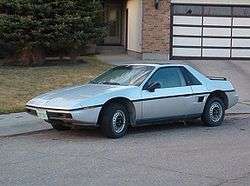
Introduced for the 1984 model year, the Pontiac Fiero was an instant hit due to its styling and mid-engined layout. However, it eventually garnered a negative reputation due to its poor performance, many reliability issues and a highly publicized recall due to engine fires. Including it in Automotive Atrocities, Eric Peters said of the Fiero, "GM's penchant for doing things on the cheap ruined what could have been a great car. The mid-engined Fiero 2M4 looked great and instantly became one of the sensations of the 1984 model year - until people realized those sexy, dent-resistant body panels hid Chevette running gear."[10] Top Gear writer Richard Porter included the Fiero in his book Crap Cars, claiming that by basing the Fiero on the Chevette, "Pontiac engineers worked tirelessly to erase whatever excitement [The Fiero's design and layout] might have inspired, chiefly by snuffing out anything that might pass for acceleration."[11] Edmunds.com ranked the Fiero as the 58th worst car of all time.[8] In a 2015 retrospective, Road & Track magazine called the Fiero "misunderstood" and noted that it not only failed due to its poor performance, but also due to the downtrodden image it eventually acquired in American culture, which hampered its long term reputation in contrast to the very similar Toyota MR2; "... the 90's were hard on the poor car. A lot of Fieros were trashed by the mid 90's [...] The Fiero became a car for divorced 40-year-olds, male or female, who felt they deserved something nice in their lives again. Here was a sporty-looking used car that was more striking than their Mercury Lynx CE14."[58]
Yugo (1985–92)
.jpg)
The Yugo, a modified Zastava Koral from Yugoslavia sold in the United States, was roundly panned for its poor performance, poor build quality and numerous safety defects, enough to where the car became the frequent butt of jokes during its time.[23] The cover of the February 1986 issue of Consumer Reports featured a Yugo getting stared down by a Peterbilt truck with the caption "How much car do you get for $3990?"[23] The included review, which slammed the car as a "barely assembled bag of nuts and bolts", said that a used car was a better buy.[23] In 2000, Car Talk voted it the "Worst Car of the Millennium".[23] Additionally, the Yugo was included on Time magazine's list of the 50 worst cars of all time and CNN's list of the "10 Most Questionable Cars of All Time". Dan Neil wrote that the Yugo is the "Mona Lisa of bad cars" that "had the distinct feeling of being assembled at gunpoint."[6] CNN said of the Yugo, "Chinese car companies are now talking about entering the U.S. market, so you'll see the Yugo cited frequently as an example of how not to do it. Lesson number one: There is a definite limit to what Americans will accept in exchange for a low price [...] But the Yugo's reputation for awful build quality - which some dogged defenders still insist was undeserved - quickly became the stuff of legend. Yugo jokes were almost as numerous as lawyer jokes and just as scathing."[16] Including it in Automotive Atrocities! The Cars We Love to Hate, Eric Peters said that the Yugo was "less reliable than the exchange rate of an African 'people's republic' or a Halliburton financial disclosure", that it "[taught] folks the hard way about getting what you pay for" and that "The Yugo will likely hold in perpetual ignominy the title of 'Worst Car Ever Sold to the American Public'".[10] Jeremy Clarkson drove a Yugo 45 and called it a "hateful, hateful car"; Describing its performance as so bad "you'll get overtaken by wildlife," Clarkson eventually destroys it with a tank.[59] Edmunds.com ranked the Yugo as the 4th worst car of all time: "A Serbian-made version of the Fiat 127 that couldn't possibly be as awful as its low price suggested. But it was! Currently celebrating its 25th anniversary as shorthand for automotive crap."[8] The story of the car was chronicled in the book The Yugo: The Rise and Fall of the Worst Car in History by Jason Vuic, published in 2011.[60]
General Motors E-Body luxury cars (1986–93)
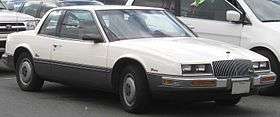

In 1986, General Motors released redesigned, downsized versions of its E-body luxury cars, the Buick Riviera, Oldsmobile Toronado, Cadillac Seville and Cadillac Eldorado. While they were very technologically advanced, with the Riviera being the first production car to have a touchscreen computer in the dashboard,[61] the cars were strongly rejected by consumers. Riviera sales halved with the introduction of the new model and dwindled to 8,500 units by 1988 in an 87% reduction from 1985,[62] with similar sales drops for the Toronado and Cadillacs.[63] In naming the 1986 Riviera (and later the 1986 Seville in a separate entry) among the "deadly sins" that lead to GM's downfall, The Truth About Cars struggled to think of another car that saw a similar sales drop not aided by a recession or an energy crisis; "It wasn’t only the loss of sales of these once glorious coupes that was such a mortal blow. It was what these cars once represented: GM as a purveyor of excellent design, desirable image, decent build quality, and a stranglehold on the mid-upper premium market segment. All these were utterly destroyed."[63] The poor sales of these cars have been attributed to their small size and generic styling, which made them strongly resemble GM's entry level models[63];"It wasn’t just that the $27k ’86 Seville looked too much like an $8k Oldsmobile Calais, which even preceded the Seville by a year. It’s also the fact that all these cars just didn’t look good, period [...] [Looking at them] you can’t help but wonder what the hell was going on at the once-vaunted GM Design Center."[64] Popular Mechanics retroactively criticized the Riviera's interior and controls, stating that customers found the computerized dashboard "onerous and distracting".[61] The Oldsmobile Toronado Trofeo is included in the book Automotive Atrocities! The Cars We Love to Hate with author Eric Peters writing, "When it appeared in 1966, the front wheel drive Oldsmobile Toronado was a show-stopper - one of those "gotta-have" cars that young men pine for almost as much as cheerleaders [...] Twenty years later, a miserable pretender appeared, wearing the Toronado name but partaking of none of the old car's glory." [10] The Toronado was similarly skewered by Top Gear writer Richard Porter in his book Crap Cars.[11]
Cadillac Allante (1987–93)
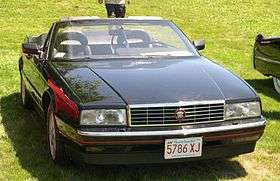
The Cadillac Allante, introduced for the 1987 model year, was a top level convertible intended to compete with the Mercedes-Benz SL. However, the Allante was a major commercial failure, selling less than 5,000 units a year until it was cancelled in 1993. The Allante was hampered by poor performance, being a front wheel drive car powered by a 170 horsepower engine while weighing 3600lbs; Motor Trend measured the Allante as having a 0-60 time of 10.3 seconds, 4 seconds slower than the Mercedes.[65] This led to the press dismissing the Allante as "all show, no go".[65] The Allante was also beset by numerous quality issues, most notably a leaky convertible top - an issue GM was found to have known about but ignored prior to the car's launch - and expensive problems with its Bosch anti-lock brakes.[66] While GM fixed the Allante's flaws throughout its production run, the combination of its early quality problems, a redesigned Mercedes-Benz SL launching in 1989 and the early 1990s recession tanking luxury car sales doomed the car. Including the Allante in Automotive Atrocities: The Cars We Love to Hate, author Eric Peters lamented that the Allante "coulda been a contender"; "What turned this magic coach into a pumpkin was the car's dreadful initial quality, exorbitant price, and the less-than-world-class performance."[10] In a retrospective, CarThrottle wrote that "The Cadillac Allanté is considered a poster child of what's wrong with GM."[65] Describing the Allante as "wildly overpriced, bland and sloppy handling" which "hit the market with a thud," The Truth About Cars offshoot side Curbside Classic wrote of it, "If ever there was a metaphor for GM’s deaf, dumb and blind market comprehension, this was it. The fact that the Allante had to be designed and partially assembled in Europe spoke loud and clear that the solons in corporate HQ had lost touch with their target buyer (and economic reality)[...] Even with its towering $54,000 sticker price, buyers got leaky roofs, troublesome Northstar engines and sluggish acceleration. To beat it all, GM lost money on every Allante ever made."[67] Edmunds.com named the Allante the 23rd worst car of all time, describing it as "pointless" and an "embarrassing attempt to take on the Mercedes SL."[8]
Sterling 825/827 (1987–91)

The Sterling 825 was a slightly modified Rover 800 created for export to the United States. The 800, in turn, was joint developed with Honda and was very similar in design, and shared most of its mechanical components, with the Acura Legend. The Sterling, suffering from numerous build quality and reliability problems, ended up being a major commercial failure, in marked contrast with the success of the concurrently launched Acura. Naming it one of the worst flops of the past 25 years, Car and Driver retroactively wrote of it, "... on paper, it made sense: Take a Rover 800—which was really just a rebodied Acura Legend—rebadge it, and sell it through a network of independent dealers under a new, made-up brand [...] Japanese reliability, British interior ambience, and a lack of preconceived notions? How could you lose? Quite easily, as it turned out. Predictably, the problem lay in the car itself—the first Sterlings were nothing short of unreliable, hastily screwed-together nightmares. (Apparently, Japanese engineering doesn’t work if you assemble it with equal parts wood glue and indifference. Who knew?)"[68] Jalopnik named it one of the dumbest cars ever imported to America, saying to "think of it as a classy but terrible Acura."[69] Autotrader.com retroactively wrote of the Sterling, "The Rover 825 came to the U.S. in 1987 under the Sterling brand name. Initially, U.S. buyers were intrigued – remember, this was at the height of Reagan-Thatcher cooperation, and just a few years after Prince Charles and Princess Di got hitched. The UK was cool in the U.S., and buyers were enticed by the wood-trimmed dash, the leather-lined seats and the slick fastback body not offered on the U.S.-market Acura Legend. Besides, the engine and the mechanical bits were from Honda. How bad could it be? [...] Plainly put, what passed for decent build quality in Britain was pathetic in the U.S. And so it went with the Sterling 825. Trim fell off. Electricals failed. The paintwork was terrible. And after a few short years, the car started to rust. Contemporary J.D. Power surveys told the story: The Sterling was near the bottom, while the Acura Legend was near the top. One of the unique selling points of the Sterling, by the way, was the Sterling Plus Motor Club, which offered hotel accommodations for stranded owners – one marvels that Rover didn't go bankrupt from the lodging bills."[70] Autotrader also noted that despite the Sterling's failure, the same export initiative also brought Land Rover to America.[70] Included in Automotive Atrocities: The Cars We Love to Hate, author Eric Peters made note of the Sterling's shared development with the Acura Legend and wrote of it, "While Acura would go on to great things, the half-breed spawn of this odd one-night stand would go down as one of the greatest commercial flops ever [...] Given Acura's 'Sterling' reputation today as a manufacturer of first-class luxury cars - and the well-known success of the Legend in the United States - it's hard to understand why the essentially similar Sterling 825 and 827 went belly-up so quickly [...] [Buyers] quickly encountered defeating problems such as dashboards that turned a hideous green in the sunlight and other fit, finish and build quality issues related to the car's chintzy British-sourced [cosmetic pieces]".[10] Including it in his book Crap Cars, Richard Porter wrote of it, "It seemed like such a good idea. Rover of Britain and Honda of Japan would join forces to make a luxury car. The Japanese would bring the build quality, reliability and precision engineering. The British would garnish it with their talent for suspension tuning and tasteful design [...] What could possibly go wrong? For Acura, nothing. For Sterling? Absolutely everything. [...] The only bit of the Sterling that was even remotely dependable was the engine. And - surprise, surprise - that came from Honda."[11] Edmunds.com ranked the Sterling 825 as the 68th worst car of all time.[8]
Eagle Premier (1988–92)
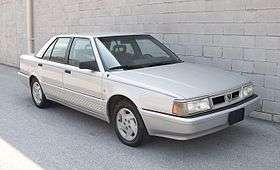
The Eagle Premier - also sold as the Dodge Monaco - was a large sedan developed as a joint venture between American Motors and Renault, launched after AMC was bought out by Chrysler. Chrysler established a new brand, Eagle to market it. While a commercial failure, the Premier formed the basis of the company's successful LH platform cars, the 1993 Dodge Intrepid and Chrysler Concorde. Naming it one of the dumbest cars ever imported to America, Jalopnik said it was "developed at the final moments of AMC's Renault clusterfuck before Chrysler took over. It's quite a story (seriously, it's even got a high-level Cold War assassination)!"[69] Autoweek retroactively wrote of it, "The Premier ultimately fell victim to poor timing – AMC started to unravel just as the sedan entered production. Chrysler would inherit most of AMC, and the very first Premiers left the factory with a mishmash of Renault and Eagle badges attached to various surfaces [...] The Premier suffered from an identity crisis from the start, and by the time it was suddenly rebadged as an Eagle – an all-new brand created out of thin air for AMC leftovers – and then as a Dodge, consumers weren't really sure what they were buying."[71] Autoweek also noted that the only place to find a Premier today was at a junkyard, as because of their poor reliability and difficulty in finding a shop that can service one, the Premier "disappeared pretty quickly" off American roads.[71] Edmunds.com ranked the Premier as the 98th worst car of all time, describing it as a "boring box built around the Renault 25 chassis".[8] TheStreet.com ranked the Premier the worst car of all time, noting its complete lack of redeeming qualities; "You may look at this car and think to yourself, 'that's not that bad.' But what it is that makes this car particularly terrible, it's what it is not. When you get into this car, you feel nothing. There is nothing special or unique about the Eagle Premier [...] This car looks like the generic silhouette of a vehicle in which you would spot only on a 25-year old poster that has been hanging in tired DMV, generic and apathetic in nature, faded and defeated from years of exposure to florescent [sic] lighting and the restless complaints of impatient souls. It is a symbol of sheer indifference and nothingness."[72]
Chrysler TC by Maserati (1989–91)
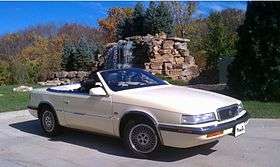
The Chrysler TC by Maserati, introduced in 1989 after years of production delays, was the result of a deal between Chrysler CEO Lee Iacocca and his friend, Maserati head Alejandro de Tomaso to create a top-line sports car for Chrysler. The resulting vehicle was a critically panned commercial failure, due to it being based on K-car mechanicals and it both having a strong resemblance to and being only marginally more capable than the much lower priced Chrysler LeBaron convertible. Including it on its list of "The Greatest Automotive Flops of the Past 25 Years", Car and Driver said of it, "Arrogance, thy name is Lee Iacocca. In the late 1980s, the Chrysler chairman and perpetual huckster turned a friendship with Alejandro de Tomaso, then president of Maserati, into the most shudder-worthy example of corporate avarice ever to roll off an assembly line. Chrysler’s TC by Maserati was little more than a Milan-built K-car with a few pricey underhood components and some styling hackery, a wrinkly grandmother dressed up in custom running shoes and ill-fitting hot pants. The Maserati trident plastered on the grille just added insult to injury."[68] Included in the book Automotive Atrocities: The Cars We Love to Hate, author Eric Peters wrote of it, "If you slipped a wino into a pair of Bruno Magli shoes, not many people would believe he was actually Pierce Brosnan out for an incognito stroll. Yet Chrysler Corp. thought that a similar quickie Italian makeover would work wonders for its K-car-based, front-wheel-drive LeBaron coupe [...] [Expecting a buyer to pay significantly extra for the TC over a LeBaron] was like expecting people to pay $20 for a Quarter Pounder with cheese if it was called a Royale with cheese and served on a china plate instead of purveyed to you wrapped in greasy paper."[10] Peters also noted that the TC is the only Maserati car to have no collectible value.[10] The TC is featured in the book Crap Cars, in which author Richard Porter says of it, "Best of all was an advertisement for the TC that claimed that this crock was 'built and handcrafted'. Built and handcrafted? So they bolted it all together, and then added the handcrafted bits?"[11] Edmunds.com ranked it as the 15th worst car ever made; "Stupid combination of front-drive K-Car bits, indifferent Maserati assembly in Italy and a two-seat roadster body that was indistinguishable from a LeBaron. It's both the worst Maserati and worst Chrysler ever."[8] Dan Neil described the TC as being "a flaccid, front-drive, four-cylinder loser-mobile with the proud Mazzer Trident on the nose."[6]
1990s
Chrysler Imperial (1990–93)
For the 1990 model year, the Chrysler Imperial nameplate was applied to a long-wheelbase variant of the Chrysler K platform. The 1990 Imperial was #10 on Autoblog's list of "The 20 Dumbest Cars of All Time", with the author criticizing its out of date mechanicals and cheesy styling, claiming that the Imperial is evidence that "Lee Iacocca should have been banned from design studios at some point" and suggested that the Imperial is a reason to reevaluate Iacocca's legacy.[5] Included in Richard Porter's book Crap Cars, he said of the Imperial, "[it] was based on the K-car, which, as bad starts go, is up there with being the offspring of Tom Arnold. To cover the embarrassing parentage Chrysler had to disguise it, apparently by asking everyone in the company for styling suggestions. And then they used them. All of them."[11]
General Motors U Platform minivan (1990–96)

The 1990 General Motors U Platform minivan, sold as the Chevrolet Lumina APV, Pontiac Trans Sport and Oldsmobile Silhouette, was introduced for the 1990 model year in an attempt to provide a stylish alternative to the Dodge Caravan. However, it was strongly criticized for its awkward driving position and strange styling, with many publications nicknaming the vans "Dustbusters" due to their resemblance to a popular handheld vacuum cleaner of the same name. In Crap Cars, Richard Porter describes the van as "[Resembling] an enormous Dustbuster with detailing work by a group of lightly trained monkeys."[11] The Trans Sport was included on CNBC's list of the "10 Ugliest Cars of All Time." The Truth About Cars offshoot site Curbside Classic named the Lumina APV as one of the "deadly sins" that led to GM's downfall; "There are two primary reasons GM vehicles have failed. They either arrived with deadly flaws in their quality/reliability, like the Vega, Citation and quite a few other models. Or they were conceived in GM’s notorious bubble of hubris, where its product planners and designers were seemingly perpetually stuck in a Jetsons-Futurama mind set, convinced that they could wow Americans with more advanced design and technology. What Americans really want is a minivan that looks like a space shuttle! Not. [...] The most obvious feature of these vans are their extremely long noses, the huge low-slope windshield, and the set-back front seats. The combination of the three created a very distinctive visual effect from the outside that caused them almost instantly to be dubbed 'Dustbusters'. The effect from the front seats was also disconcerting, as there was a ledge in front of the dashboard that seemed to go on for eternity, creating the feeling of sitting in the second row of more typical minivan. It would have made a nice platform for a bed if these were autonomous."[73] Edmunds.com, describing the van as being "stupid looking", ranked it the 86th worst car of all time.[8] The van was parodied in a 1997 episode of US TV series The Simpsons. Despite their derision in North America, the Trans Sport proved popular in Europe, particularly in France, as its styling and layout was similar to the contemporary Renault Espace.[73]
Vector W8 (1990–93)
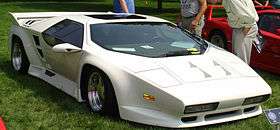
The Vector W8 was a Supercar built by the American manufacturer Vector Motors. Developed through the 1980s and promoted with its Vector W2 prototype, the W8 was delayed numerous times and didn't go into production until 1990. Only 17 examples were completed before the company collapsed. The car received negative publicity almost immediately due to one of the first W8s being purchased by star Tennis player Andre Agassi, which nearly caught on fire his very first time driving it.[74] Agassi, describing the car as a "death trap", went to Vector founder and CEO Gerald Wiegert, returned the car and demanded a refund, which Wiegert obliged.[74] In 1991 Car and Driver attempted a road test of the W8 but all three production models supplied broke down in different ways during testing.[75] In a 2017 piece, Car and Driver described the W8 as being "vaporware", apologized for the positive publicity the publication gave Vector during the 1980s, and claimed the Vector W8 is the reason why the publication never believes any manufacturer's claims about a new model without testing it themselves.[75] Jalopnik included the W8 on its list "Ten Totally Bogus 90s cars"; "When they were running, they may have been great cars, but the W8 was a combination of 80s style with 70s quality, making it the most backward sports car of a forward-looking decade."[76] Edmunds.com named the W8 the 93rd worst car of all time: "Gerald Wiegert's 625-hp, $400,000-plus folly was obsolete by the time it finally hit production. Only 17 reached customers — and they needed to be shadowed by a flatbed."[8]
Suzuki X-90 (1995–97)
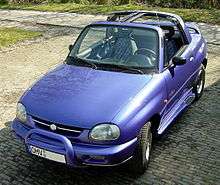
The Suzuki X-90 was a small SUV based on the Sidekick/Vitara and was a crossover between SUV, roadster and buggy with a T-top roof and replaced the Samurai in the US market. It was supposed to be a small, fun leisure time car but was heavily criticized for its sparse interior space, having only two seats and a small boot, as well as its poor performance, bad road handling, lack of driving fun and controversial styling. Furthermore, it was priced higher than the Sidekick which featured four seats and more interior room, luggage space and practicability at a lower price. The X-90 was featured in the books "The Worst Cars Ever Sold" by Giles Chapman,[2] "Crap Cars" by Richard Porter[11] and "Naff Motors: 101 Automotive Lemons" by Tony Davis.[3] In October 2013, Top Gear Magazine placed the X-90 on number 10 of its list of "The 13 worst cars of the last 20 years", saying "Evil progenitor of the pre-TOWIE Essexmobile, the Vitara SUV, the X-90 compounded Suzuki’s reputation for marketing-led myopia and wobbly handling." [77] TheStreet.com ranked it 15th in its list of the 20 Worst Cars of All Time, saying "After looking at this car, it may not be a surprise to anyone that Suzuki no longer produces cars in the U.S. Not only does the car look near exactly the same going forward as it does going backwards, it is almost as if the manufactures simply forgot the middle part of the car."[78] The Telegraph ranked it 7th in its list of the "10 worst cars ever sold in Britain", commenting: "Who wanted a two-seater convertible mini-SUV? Nobody, especially when it had awful handling and zero off-road ability."[79] Stuff.co.nz included in an article on Cars that should never have been built, saying about it: "Suzuki did wonders with the X90 by redesigning the early Vitara to look like a back-scrubbing shower accessory, on the way halving its passenger capacity and turning an excellent new junior 4x4 into a blobby, saleproof nightmare."[80]
Vector M12 (1996–98)

The Vector M12 was a repurposed version of the Vector WX3 prototype manufactured after the company's hostile takeover by Indonesian company Megatech, borrowing a number of its mechanical parts, including its V12 engine, from the Lamborghini Diablo. In a period review for Top Gear, Jeremy Clarkson gave the M12 a negative mark, claiming that it "was cooked by a man who learned everything there is to know about quality control in a Bulgarian power station"; he noted that the air conditioning system didn't work properly, the driver's door didn't fit, one of the HVAC vents can be pushed into the dashboard, and that he could smell petrol inside of the car. While noting that the M12 could be pleasurable to drive around a track, he deemed it not worth buying.[81] Autoweek magazine deemed the M12 to be the worst vehicle the publication has ever tested.[82] Vector entered the M12 in auto racing events to establish brand equity but only received more negative publicity as the M12 never completed any of the races it was entered in due to mechanical failure.[82] Eventually, production ended with only 17 units built before Vector went into receivership because it couldn't afford to pay Lamborghini to ship more engines. In a retrospective, CarThrottle described the M12 as a "botch job" and noted of its low production, "would-be customers found it hard to justify spending $189,000 on a canoe-bodied car that was slower, uglier and of lesser build-quality than [the Lamborghini Diablo]."[82] MSN Autos included the M12 on its list of "The World's Worst Supercars".[83]
Cadillac Catera (1997-01)
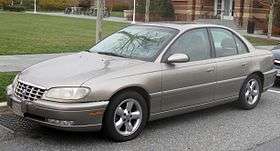
The Cadillac Catera was Cadillac's second attempt to market a smaller, sportier model to appeal to a younger demographic after the failure of the Cimarron in the 1980s. A modified Opel Omega, the Catera was again aimed at compact German luxury cars like the BMW 3 Series. While it was better received by critics than the Cimarron, the Catera was again a commercial failure as it was unable to match its German rivals in performance and capability while also failing to appeal to Cadillac's existing customers. It's unorthodox marketing campaign, featuring model Cindy Crawford and a cartoon duck named "Ziggy", has been retroactively panned and cited as a factor in the Catera's failure. The Catera was also had numerous reliability issues and quickly developed a reputation as being problem-ridden; the Catera broke down multiple times while being tested by Automobile magazine.[84] Naming it one of the "10 Most Embarrassing Award Winners in Automotive History", Car and Driver retroactively wrote of it, "Despite an ad campaign that featured both Cindy Crawford and animated versions of the ducks found on the Cadillac crest, there was just no way to hide the fact that the Catera was a snoozer. The styling was generic and gelatinous, the interior bland, and the chassis response lackadaisical, and the 3.0-liter V-6’s 200 hp had to strain against a nearly 3900-pound curb weight[...]About the only thing truly interesting about the Catera was its calamitous reliability record."[25] Autoweek described the Catera as "badge engineered bomb"[71] while Popular Mechanics described the Catera as "a car that couldn't zag into obscurity quickly enough" while including it on their list of "10 Cars That Deserved to Fail".[85] Jalopnik named the Catera one of the worst German cars of all time[86] and U.S. News & World Report listed the Catera's "Princess" advertisement as one of the worst car commercials of all time, describing Ziggy as "a bargain-basement imitation of a Looney Tunes character" while describing Crawford's character as a "sexist representation of women".[87] The Truth About Cars-offshoot site Curbside Classic noted that the Catera strongly resembled the much lower priced 1997 Chevrolet Malibu that was launched at the same time, described its "The Cadillac That Zigs" ad campaign as "stupid" and noted that the Catera's poor resale value caused large financial losses for GM since a majority of them were sold on lease. However, they also noted that the Catera convinced GM's management to continue to make Cadillacs smaller and sportier, leading to the creation of the successful and critically acclaimed Cadillac CTS which lead to the brand's resurgence as a German import fighter in the 2000s.[88] Edmunds.com named the Catera the 22nd worst car of all time.[8]
2000s
Pontiac Aztek (2001–05)
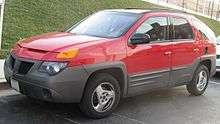
From its launch the Pontiac Aztek earned a strongly negative reception, mainly for its controversial styling, which former General Motors executive Bob Lutz described as resembling an "angry kitchen appliance".[89] Autoblog listed the Aztek #2 on its list of "The 20 Dumbest Cars of All Time", criticizing its styling and stating, "GM execs cheaped out here, and were leading a system which minimized the influence of competent designers, and maximized the influence of accountants to produce cars at the cheapest cost."[5] In its entry on Time magazine's list of the 50 worst cars of all time, Dan Neil wrote, "I was in the audience at the Detroit auto show the day GM unveiled the Pontiac Aztek and I will never forget the gasp that audience made. Holy hell! This car could not have been more instantly hated if it had a Swastika tattoo on its forehead."[90] In a later piece, Time also named the Aztek one of the 50 worst inventions of all time.[91] The Los Angeles Times named the Aztek the "Worst Car Ever Sold in America".[14] The book Sixty To Zero by Alex Taylor III, which details the fall of General Motors, prominently features an Aztek on the cover. CNBC listed the Aztek as one of the 10 ugliest cars of all time.[15] Popular Mechanics listed the Aztek as one of the 10 cars that damaged GM's reputation, as the Aztek's styling hampered GM's attempt to get a jump on an emerging market.[26] The last entry in Automotive Atrocities! The Cars We Love to Hate, Eric Peters says of it, "The only vehicle to look like it's been in a bad accident even before it left the factory, the Aztek will be remembered as evidence that advanced degrees in automotive design are not necessarily indicators of good taste – or spelling ability."[10] Consumer Reports revealed in 2014 that they conducted most of their testing of the Aztek at night because staffers were embarrassed to drive it, and that the aforementioned Aztek was still in their possession because they were unable to sell it when liquidating that year's test fleet.[92] Edmunds.com ranked the Aztek as the worst car of all time; "Drive one and you quickly realize that the Aztek's exterior design is its best feature. It's the very worst car of all time because it's the only car on the list to kill an 84-year-old car company. It's undeniable that the Aztek's utter hideousness drove the biggest and last nails into Pontiac's heavily side-clad, plastic coffin."[8]
Hummer H2 (2002–09)
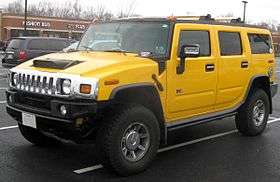
The Hummer H2, built off of the GMT800 platform, was introduced in late 2001 for the 2002 model year. The H2 was polarizing when introduced and has since gained extremely negative retroactive recognition as well as a negative social-political image in the United States. Including it on Time magazine's list of the 50 worst cars of all time, Dan Neil wrote of it, "One struggles to think of a worse vehicle at a worse time. Introduced shortly after 9/11 — an event whose causes were tangled in America’s unquenchable thirst for oil — the Hummer H2 sent all the wrong signals. It was/is arrogantly huge, overtly militaristic, openly scornful of the common good. As a vehicle choice, the H2 was a spiteful reactionary riposte to notions that, you know, maybe we all shouldn’t be driving tanks that get 10 miles per gallon [...] The H2 was also a PR catastrophe for GM, who happened to be repossessing and crushing the few EV1 electric cars at the time. It all contributed to GM’s emerging image as the Dick Cheney of car companies."[6] Popular Mechanics listed the H2 as one of the 10 cars that damaged GM's reputation, noting how it was launched around the same time as the Toyota Prius, was "politically incorrect in an era where the forces of political correctness [were] winning" and used styling that resembled a military vehicle as a selling point while opposition to the Iraq War was at a fever pitch, compounded with the huge financial losses the Hummer brand brought when sales collapsed during the 2000s energy crisis, leading them to summarize the H2 as "a self-inflicted headache GM [didn't] need".[26] Car blog Jalopnik named the H2 one of the 10 worst cars of the 2000s decade; "Say hello to the Sierra Club's Antichrist: The H2 is the younger brother of AM General's massive Hummer H1. GM birthed this overfed monstrosity in an effort to bring the H1's street cred and off-road talent to America's middle class." Jalopnik noted it has excellent off-road capabilities but "The interior is cramped, chintzy, and claustrophobic. Frame and mechanicals are largely last-gen Chevy Tahoe/GMC Yukon bits, only they carry more weight and complain more often."[93] Autoblog included it on its list of "The 20 Dumbest Cars of All Time", stating, "The Hummer H2 may have tried to appeal to outdoorsy adventure seekers, but what it attracted were mostly people who advocate for tofu to be actually banned by law [...] [The H2 eventually became] the poster cars for American excess and environmental insensitivity. Few other vehicles created such a visceral response from others than the Hummer H2 [...] The whole vehicle was in really bad taste, though we understand there are plenty of state militia and World Wrestling Federation fans who think otherwise."[5] ConsumerGuide included the H2 on its list "The Ten Worst Cars in the Past Ten Years"; "Though reasonably capable off road, the H2 wasn’t actually fun in the wild. It was difficult to see out of, and far too wide to navigate the type of twisty trails most often enjoyed by Jeep enthusiasts. Additionally, the H2’s cabin was made mostly of hard, industrial-grade plastic, and its thirst for fuel was exacerbated by the need for pricey premium gas. The worst part, though, was driving a vehicle that became the poster child for vehicular conspicuous consumption."[94] Forbes named it on its list "12 Most Embarrassing Cars", noting that the Hummer H2's "wretched excess" arrived at a time when the large SUV fad was beginning to end.[95] The H2 is prominently parodied in the 2008 video game Grand Theft Auto IV in which the player can drive one with extravagant American flag decals on the side. In 2017, Autotrader published an article and accompanying video entitled "The Hummer H2 Is the Most Embarrassing Car You Can Buy", in which automotive writer Doug DeMuro rents one from Turo and drives it around Florida: "I simply had to know what it was like; I had to know how it felt; I had to know if everything I ever assumed about it was true. And I'm happy to report that it is true – that the H2 is just as bad as you could've ever expected. Now you can feel like you're justified when you see one driving down the road and you start to chuckle."[96]
Jaguar X-Type (2002–09)
_SE_sedan_(2011-06-15)_01.jpg)
Launched in summer 2001, the Jaguar X-Type, designed to compete with compact luxury cars such as the Mercedes-Benz C-class, was a commercial failure that has earned derision for being based on the Ford Mondeo. Named one of the 50 worst cars of all time by Time magazine, Dan Neil wrote of it, "In its attempt to turn [the Mondeo] into an “all-wheel drive” sports sedan, Jaguar ran smack into the limits of platform engineering. The result was the English version of the Cadillac Cimarron, a tarted-up insult to a once-proud marque and a financial disaster for the company."[6] The New York Times dubbed the X-Type "The Worst Car of the Decade".[97] AOL UK named the X-Type one of the worst cars of the 2000s decade.[98]Car and Driver wrote of the X-Type, "Engines seized, interiors collapsed, transmissions exploded, and driveshafts—oh, the countless, countless driveshafts—ate their U-joints so regularly that you could set your watch by them. At a time when Jaguar reliability was finally approaching respectable, the all-wheel-drive X-type was the lone, laughable holdout. It was obnoxiously underbuilt, remarkably overpriced, and about as charming as a hernia."[68] Edmunds.com ranked the X-Type the 84th worst car of all time, describing it as Jaguar "Spitting on its own heritage".[8]
Lincoln Blackwood (2002)
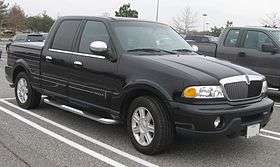
The Lincoln Blackwood is a pickup truck version of the popular Lincoln Navigator SUV. The Blackwood was a major commercial failure and was withdrawn from the market in a year, with it taking two more years to sell off the remaining inventory.[5] Reviewers slammed it for its lack of utility and off-road capability. Naming the Blackwood one of "The 20 Dumbest Cars of All Time", Autoblog stated, "Ford CEO Jacques Nasser and his luxury brand chief Wolfgang Reitzle thought it was a great idea: a luxury Lincoln branded pickup truck with a trunk instead of a flat bed and pin-stripe painting to mimic a business suit. [...] [The Blackwood was] one of those vanity projects hatched at the top."[5] Car and Driver named it one of the worst flops of the past 25 years and said of it, "Check out the cargo box: It’s lined in carpet and gen-yoo-wine stainless steel. That’s stainless —means it can’t be stained. You can’t carry nuthin’ heavy or dirty in it without uglying it up, but it makes for a nice trunk, see?"[68] Jalopnik named the Blackwood on its list of "Ten Cars That Should Have Never Left the Factory"; "Riding the cheap upgrade, big margin wave of the Navigator, Ford gave its F150 the same treatment, calling it the Blackwood. Except they stripped out every ounce of actual utility from the vehicle, save for towing, by making it a RWD only pickup with an Aluminum lined, carpeted, power tonneau'd bed [...] This was where they decided to pour their resources rather than refining their new RWD LS sedan. This is a symbol of the fall of the brand. Now we're stuck with a lifeless shell of a company, making badge engineered Fords that bastardize the Mark (MK?) name."[99]
Renault Avantime (2002–03)
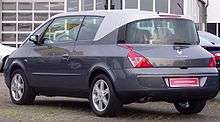
When Renault started manufacturing their new generation of Espace MPV in-house instead of at Matra, the latter company needed a new product to build. Renault chose to create a kind of luxury coupe on the basis of the old Espace. According to Craig Cheetham in his book 'World's Worst Cars', "the car was doomed to failure by its very concept."[4] Despite being based on the same platform as the Espace minivan, the car was designed for just four people with the fifth one being a squeeze, and rear legroom was disappointing. Retaining the height of an MPV, the car appeared tall and ungainly. With only 8,557 units sold, the Renault Avantime became one of the biggest sales flops in automotive history, making it more numerically rare than some models of Rolls-Royce or Ferrari. In 2003 production was halted due to the bankruptcy of the Matra car production company.[100]
Renault Vel Satis (2002–09)
.jpg)
Alongside the Avantime, Renault's other effort to get into the luxury market at that time was a more conventional, but still rather oddly designed four-door hatchback limousine called Vel Satis. Despite receiving some praise for its high level of comfort, its roadhandling was considered poor and its design was controversial and often ridiculed by some, as designer Patrick Le Quément was primarily interested in presence rather than elegance. AOL ranked it the 9th worst car of the 2000s, saying that "the French company was off to a loser from the off thanks to the Vel Satis's ugly looks and driving dynamics that were way off the pace. The most distinctive but unattractive design features include the large front headlight units and bloated rear styling."[101] The Oxford Mail included it in its "The worst cars Evah!" series, saying that it "looked like a cartoon with a radiator shaped like a gaping tooth-filled mouth. All it needed was a Gauloises cigarette wedged on one side and the image would have been complete. [...] Even the French thought Renault had gone mad and sales were disastrous. Instead of being sexy and sophisticated, it was seen as fat and ugly."[102] Autocar.co.uk included it in an article on "The worst cars of the decade", commenting: "Lumpy looks and a lumpy ride, for both the occupants and its maker."[103] The car was facelifted in 2005 when Renault stopped making the right-hand drive version. The revised model continued until 2009, and the successor model can be considered to be the Renault Latitude.
Rover CityRover (2003–05)
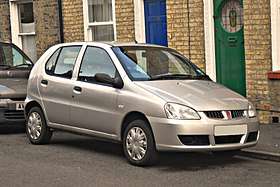
The Rover CityRover was a rebadged Tata Indica fitted for European regulations and sold in the UK and Continental Europe. It was the result of MG Rover wanting to offer a new small car after the discontinuation of the Rover 100 in 1998 and of the Mini in 2000, but as the company was in financial trouble and had no money to develop a new small car on its own, they entered a deal with Indian Tata Motors. MG Rover was reported to be paying Tata £3,000 for each car and, despite each model featuring a Rover corporate nose and revised suspension settings, the £6,495 starting price was considered too high. In May 2004, Rover refused to lend a CityRover to motoring show Top Gear to test it, so James May went undercover and test drove one at a dealer while carrying a hidden camera. May went on to say that it was the worst car he had ever driven on the programme.[104] Sales were well short of MG Rover's targets, so the CityRover was given an upgrade for the model year of 2005, with more standard equipment. In December 2004, prices were reduced by £900, confirming that the car's previous prices had not been competitive.[105] According to car reviewer Parker's, the CityRover was the worst rated Rover car from MG Rover, with a rating of two out of five.[106] In October 2013, Top Gear Magazine placed the CityRover at number six on its list of "The thirteen worst cars of the last twenty years", stating "The Rover CityRover - almost certainly not the inspiration behind the Ferrari LaFerrari - wasn’t so much the last roll of the dice as the final nail in a faux-walnut coffin. [...] [T]he problem was the sheer cynicism with which it was piloted to market: you needed nine grand for a decently specced one."[77] In a 2016 Auto Express poll, it was voted the 6th worst car ever, with the article saying "The end of MG Rover was comprehensively hastened by the launch of the CityRover, a small car with few redeeming qualities [...] Even though the Rover badge carried some prestige, buyers weren't convinced by the CityRover's poor quality. The Indian-market Indica had already been in production for five years when the CityRover was launched, too, so it felt dated even as it first appeared in showrooms. [...] Poor quality, modest performance and vague handling all counted against the CityRover, especially as it was priced so highly."[107]
Chevrolet SSR (2004–06)
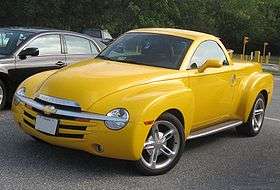
Launched for 2004, the Chevrolet SSR was a retro-styled hot rod pickup truck based on the Chevrolet Trailblazer. It was a commercial failure and earned lasting critical derision due to its Trailblazer origins and poor performance. Named one of the 50 worst cars of all time by Time magazine, Dan Neil described it as being "heavy, underpowered and unforgivably lazy. It was no more hotrod than Britney is the next Helen Mirren."[6] Autoblog included the SSR on its list "The 20 Dumbest Cars of All Time"; "The SSR answered the question no one asked. Who needs a retractable hardtop convertible roadster/pickup?"[5] Car and Driver, stating the SSR "failed miserably", named it as one of the biggest flops of the past 25 years; "It’s a convertible. It’s a pickup. It’s a car. It’s yet another example of how the American people refuse to pay for anything even remotely corporate where hot-rod culture is concerned. Yep, that’s right: It’s the Chevrolet SSR, and we can hear you yawning already."[68] Edmunds.com listed the SSR as one of the worst automotive failures of the last decade; "Is it a pickup or a roadster? Neither, because both of those can justify their existence. The retro-styled Chevrolet SSR is one of the oddest vehicles ever squeezed from Detroit's loins[...]Some say that the SSR stood out on the highway. So does a car fire."[108] Edmunds.com also named the SSR the 60th worst car of all time.[8]
Chrysler Crossfire (2004–08)
_coupe_(2015-11-11)_01.jpg)
The Chrysler Crossfire is a sports car manufactured by Chrysler that was effectively a rebodied Mercedes-Benz R170. The Crossfire was a commercial failure, with dealers having a 230 day supply of the model by November 2005, prompting Chrysler to start selling it on Overstock.com.[109] Jeremy Clarkson, on a 2003 episode of Top Gear, slammed the Crossfire, stating, "It's hard to find anything in the Crossfire that really works"; he took note of its poor handling, cheap interior, bad road feel, and stated that anyone interested in the Crossfire should buy a used Mercedes R170 instead. Most famously, he criticized the Crossfire's "hideous" styling, claiming that its rear end resembled a dog defecating.[110] Top Gear magazine, citing Clarkson's review, included the Crossfire on its list of "The 13 Worst Cars of the Past 20 Years", describing it as, "A half-decent concept that failed to make the grade in the real world[...]A first-gen Merc SLK underneath, it was outdated before it was even launched. The ultimate triumph of style over content, only without the style. Or much content."[111] The Daily Telegraph auto critic Stephen Bailey slammed the Crossfire in a 2004 review; "This is indubitably the worst car I have ever driven. It beggars belief that the aristocrats of engineering, the artistes formerly known as Mercedes-Benz, have associated their name with such an aesthetic, functional and social atrocity."[112] Naming it one of the worst car flops of the past 25 years, Car and Driver wrote of it, "What do you get when you combine a bunch of rehashed, last-generation Mercedes-Benz chassis components with overwrought styling and a bit of D-town pride? This bright-eyed hunk of weirdness, that’s what[...]Potential buyers were put off by the art-deco looks and the $35,000-plus buy-in, and many simply bought an SLK instead. Or an Infiniti G35 or a BMW 3-series, both of which were more fun to drive than the Crossfire, and neither of which looked like a dog in the middle of a life-altering dump."[68] Edmunds.com named the Crossfire one of the top automotive failures of the last decade; "The antiquated recirculating-ball steering made it slow to respond, handling was disappointing and at the same time, the ride was harsh. To further pile on the drawbacks, the interior fell short of expectations, as did overall performance and everyday convenience. In the end, not even Celine Dion could save the Crossfire, and the final insult came when remainders were sold off on overstock.com and eBay."[108] AOL UK named the Crossfire the worst car of the 2000s decade.[98]
SsangYong Rodius (2004–13)
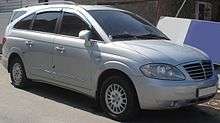
The SsangYong Rodius was a crossover between minivan and SUV and was SsangYong's first step into the minivan segment. It was praised for its roomy interior and practicability, but was highly ridiculed for its unconventional styling and is often considered among the ugliest cars ever built. It was voted the ugliest car in the UK in 2005, with an article on Jalopnik calling it an "R-Class with Down's Syndrome".[113] The styling was also notably condemned by Top Gear who said that "The Rodius is so ugly that almost everyone knows what it is; they don't know its name, but they recognise it as the car Top Gear called the ugliest car in production today."[114] Top Gear Magazine also ranked it 9th on its list of The 13 worst cars of the last 20 years.[77] The Telegraph ranked it 1st in its list of the "10 worst cars ever sold in Britain", commenting: "'Looks like a melted hearse,' is the best description of the visually challenging SsangYong Rodius we've ever heard. [...] If it were human, not even its mother could love it."[115]
Chrysler Sebring (2007–10)
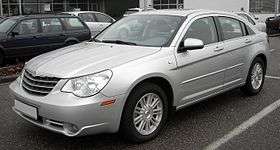
The 2007 Chrysler Sebring earned strong critical derision upon its launch. When The Truth About Cars reviewed the Sebring upon its launch in late 2006, writer Jonny Lieberman panned it and said, "I don't get it. DCX must be trying to kill Chrysler. ... Do I sound insane? Paranoid? Delusional? I cannot think of another remotely credible reason why any carmaker, knowing full well that the Camry and Accord are out there, would bring such a tired dog to market. Seriously, how profitable can rental cars be?"[116] TTAC subsequently included the Sebring on its 2007 and 2008 lists of the worst cars on the market. In a 2007 comparison test with competitors, Car and Driver placed the Chrysler Sebring in last place, stating, "Everyone who climbed aboard the Sebring felt it was aimed at buyers for which Buicks had become too racy" and that the interior looked like it had been "constructed from the parts of five different cars to look like the lobby of the Chrysler Building."[117] In a later review, Car and Driver said, "However, the Sebring is one of the least appealing cars in its class, finishing last in a recent Car and Driver comparison test of four-cylinder mid-size sedans. The engines are not especially refined, the handling and the ride are mediocre, and the interior quality is substandard. It doesn't even look that good, which is disappointing given that Chrysler used to have a reputation for excellent styling, not to mention the Sebring's handsome predecessor."[118] Jeremy Clarkson slammed the Sebring convertible in a 2008 review, saying that it was "the worst car in the world today." He continued, "All [the powertrain] did was convert fuel into noise", it had " the overwhelming sense from everything you touched that it had been built by someone who was being deliberately stupid or who was four years old" and that to buy a Sebring convertible over a Volkswagen Eos you'd have to be "so window-lickingly insane that you'd be banned from handling anything other than crayons." [119] Jalopnik.com in 2009 listed the 2007 Sebring as the 10 worst cars built in the 2000s decade; "Hailed at its launch as the cornerstone of Chrysler's post-300 renaissance; ended up a thorough disappointment and the closest thing to an Aztek-like styling catastrophe seen in years. The Sebring's spec sheet is impressive — it sports things like standard side-curtain air bags, a six-speed automatic, and an available hard-drive-equipped stereo — but it can't overcome the car's substantial faults."[93] In a separate article, Jalopnik singled out the Sebring and named it the worst car of the decade; "We're going to get this out of the way right off the bat and say yes, the second-generation Chrysler Sebring is the worst car of the decade because it's a car so awful we can't believe anyone, anywhere is still buying them."[120] Following a major refresh done to the car for the 2011 model year it was renamed the Chrysler 200 as a result of the major amounts of negative brand equity that came to surround the "Sebring" name.
Dodge Caliber (2007–12)

The Dodge Caliber, a compact hatchback released for the 2007 model year to replace the critically acclaimed and popular Dodge Neon, was a commercial failure that was slammed by critics. Of particular derision was its styling, cheap and poorly made interior, poor performance and unrefined powertrains. The Truth About Cars panned the Caliber across multiple reviews, claiming that, "the Caliber shows that bad Detroit habits are hard to break, firing blanks in this latest battle of the econobox wars" and that, "Despite an independent rear suspension, the car displays all the grace of a sumo wrestler on figure skates."[121] In another review, TTAC concluded with, "If DCX is to rally its troops and remain competitive in these fuel-conscious times, they’ll have to do better than this."[122] They subsequently named the Caliber as one of their "Ten Worst Autos of 2008"[123] and said in a review of the updated 2010 model that the Caliber is "a vehicle that a lot of folks would justifiably consider to be a loser car from a loser car company."[124] Car and Driver placed the Caliber second to last in a 2007 comparison test of entry level cars, claiming that the Caliber handled poorly and felt underdeveloped and noting that "as our test wore on, the Caliber wore thin".[125] In a subsequent review of the higher-tier Caliber R/T, Car and Driver stated that "the Caliber isn't all that good."[126] ConsumerGuide listed the Caliber as one of the worst cars of the past ten years, with the writer describing it as "the loudest, crudest, and cheapest-feeling compact car I may have ever driven."[94] Jalopnik in 2009 listed the Caliber as one of the worst cars of the 2000s decade, claiming, "It's a thoroughly depressing, indifferently built car, the kind of vehicle that Detroit needs to quit building, and quit building now." Jalopnik also noted that the Honda Ridgeline pickup truck generated better skidpad numbers and that even Chrysler engineers view the Caliber with disdain.[93] Jalopnik published a 2016 piece about taking a road trip in a Caliber titled "Three Hours Of Terror In One Of The Worst Cars Sold In The U.S. This Millennium" which described the Caliber as "a rolling symbol of American industrial decline."[127] Top Gear magazine named the Caliber as the 3rd worst car of the past 20 years, describing it as "kind of like Kid Rock in car form, although marginally less annoying."[111] Edmunds.com named the Caliber SRT-4 as the 42nd worst car of all time, claiming it was "too big and too ugly" to be a desirable performance car.[8]
Dodge Nitro (2007–12)
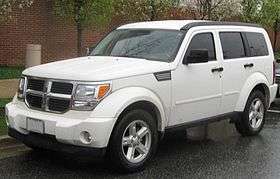
The Dodge Nitro, released for 2007, was a badge engineered variant of the Jeep Liberty with most of its off-road equipment removed. Consumer Reports slammed the Nitro, stating that its cramped interior and sluggish engine made it "a chore to drive", and was unable to name a single redeeming quality the car had.[128] Forbes subsequently named the Nitro one of the worst cars on the market in 2007.[129] The Truth About Cars listed the Nitro as one of the ten worst cars of 2008, saying of it, "Do you think [the French] care that we put panties on a few prisoners’ heads? No, they abhor our conspicuous consumption and tough-guy dress-up routines. To show them we have a sense of humor, we should send them the Dodge Nitro: a slow, cramped, artless knockoff of a HUMMER H2."[123] ConsumerGuide named the Nitro one of "The Worst Cars of the Past Ten Years"; "Desperate to compete in the exploding crossover market, Dodge tapped Jeep for a vehicle it could restyle and make its own. The result was the Nitro, an SUV that inherited all of its host vehicle’s flaws without the promise of serious off-road capability."[94]
Smart Fortwo (2007–14)

The Smart Fortwo was redesigned for 2007. This model has received a strongly negative response by the press. ConsumerGuide named it one of "The Worst Cars of the Past Ten Years"; "Power from the 3-cylinder engine is predictably limited, but fuel economy is the more troubling issue. Since it weighs just 1800 pounds and wields just 70 horsepower, one would assume the tiny ForTwo would see 50 mpg on a regular basis. Sadly, in Consumer Guide testing, we never broke 39 mpg."[94] Jalopnik named it one of the worst cars of the decade, stating that, "As 106-inch-long cars go, the Smart is pretty damn good. Nothing this size and shape should drive as well as the Fortwo does. Here's the problem: Every other car on the planet is bigger."[93] Autoblog named the Fortwo on its list "The 20 Dumbest Cars of All Time"; "For people who like to park, the Smart Fortwo is the perfect vehicle. However, if you have to drive anywhere, it won't be a fun trip."[5] Consumer Reports panned the Fortwo and stated in a 2014 video their belief that it is one of the worst cars ever made.[92] Edmunds.com named the Fortwo as the 66th worst car of all time.[8]
References
- ↑ "The Triumph Mayflower"". The Motor. 6 December 1950.
- 1 2 3 4 Chapman, Giles (2006). The Worst Cars Ever Sold. ISBN 978-0750947145.
- 1 2 3 4 Davis, Tony (2006). Naff Motors: 101 Automotive Lemons. ISBN 978-1846050640.
- 1 2 Cheetham, Craig (1 August 2008). "World's Worst Cars". The Rosen Publishing Group – via Google Books.
- 1 2 3 4 5 6 7 8 9 10 11 12 13 "The Top 20 Dumbest Cars Of All Time". Autoblog.
- 1 2 3 4 5 6 7 8 9 10 11 12 13 14 15 16 17 18 19 20 21 22 23 "The 50 Worst Cars of All Time – TIME". TIME.com. 7 September 2007.
- 1 2 3 "What's the Worst Car of the Millennium?". Car Talk.
- 1 2 3 4 5 6 7 8 9 10 11 12 13 14 15 16 17 18 19 20 21 22 23 24 25 26 27 28 29 30 31 32 33 34 "100 Worst Cars of All Time".
- ↑ "1956–1968 Renault Dauphine". HowStuffWorks.
- 1 2 3 4 5 6 7 8 9 10 11 12 13 14 15 16 17 18 19 20 21 22 23 24 25 26 27 Peter, Eric (2004). Automotive Atrocities: The Cars We Love to Hate. MotorBooks/MBI Publishing. ISBN 978-0-7603-1787-7.
- 1 2 3 4 5 6 7 8 9 10 11 Porter, Richard (2005). Crap Cars. Bloomsbury.
- ↑ Dicke, Tom (2010). "The Edsel: Forty years as a symbol of failure". Journal of Popular Culture. 43 (3): 486–502.
- 1 2 3 "Roy Brown". 2013-03-05. ISSN 0307-1235. Retrieved 2018-08-20.
- 1 2 "Bad cars: Top 10 worst cars of all time". Los Angeles Times. 23 January 2015. Retrieved 13 October 2015.
- 1 2 3 "10 ugliest cars of all time". yahoo.com. 21 March 2013.
- 1 2 3 4 5 6 7 8 "Tagged: 10 cars with bad reputations". cnn.com.
- 1 2 Wright, Parick J. (1979). On a Clear Day You Can See General Motors. Grosse Point, MI: Wright Enterprises.
- ↑ Iacocca, Lee (1984). Iacocca: An Autobiography. Toronto: Bantam Books. p. 161. ISBN 0-553-05067-2.
- ↑ NHTSA PB 211-015 "The 1960-63 Corvair compares favorably with contemporaries used in tests". National Highway Transportation Safety Administration. 1971.
- ↑ "Automotive History: 1960–1963 Chevrolet Corvair – GM's Deadliest Sin?". Curbside Classic.
- ↑ Askaprice.com (2012-04-23). "The Five Worst English Cars of All Time". Retrieved 2018-07-12.
- ↑ Gammell, Caroline (2008-07-17). "Austin Allegro voted worst car in Britain". ISSN 0307-1235. Retrieved 2018-07-12.
- 1 2 3 4 5 6 7 8 9 10 Vuic, Jason (2010). The Yugo: The Rise and Fall of the Worst Car in History. Hill and Wang.
- 1 2 3 John Pearley Huffman. "Chevy Vega Turns 40 – How the Chevy Vega Nearly Destroyed GM". Popular Mechanics.
- 1 2 3 4 5 "Dishonorable Mention: The 10 Most Embarrassing Award Winners in Automotive History". caranddriver.com.
- 1 2 3 4 5 6 7 8 "10 Cars That Damaged GM's Reputation (With Video)". 24 November 2008.
- ↑ Paul Niedermeyer. "Curbside Classics: 1971 Small Cars Comparison: Number 1 – Chevrolet Vega". The Truth About Cars.
- ↑ "Lost in Translation: Nokia Lumia, and The 5 Worst Name Oversights". International Business Times. 2011-10-26. Retrieved 2018-07-16.
- ↑ "10 cars that should never have been built". Telegraph.co.uk.
- 1 2 "10 Of The Worst Cars Ever Made In The UK". Car Throttle. Retrieved 2018-07-13.
- ↑ "The Clarkson review: Reliant Robin". Sunday Times Driving. 2016-01-11. Retrieved 2018-07-18.
- ↑ "Reliant Robin - the worst cars ever". Auto Express. Retrieved 2018-07-13.
- ↑ "Reliant Robin named worst British car of all time". The Independent. Retrieved 2018-07-13.
- ↑ "The crappest car in Britain – named and shamed in Crap Cars" (Press release). BBC. 13 October 2004. Archived from the original on 29 March 2007. Retrieved 25 April 2007.
- ↑ "Can we fix the skills shortage?". BBC. 20 February 2007. Retrieved 7 March 2008.
- ↑ Knowles, David (2007). Triumph TR7 The Untold Story. Crowood Press. pp. 86–88. ISBN 978-1-86126-891-4.
- ↑ "Die englische Krankenheit: "Der Motor des TR 7-Testwagen (TR 7-Werbung: Der Sportwagen der achtziger Jahre") gab während einer vier Kilometer langen Höchstgeschwindigkeits Messung seinen Geist auf und begann zu kochen."". Auto Motor u. Sport (in German) (19): 124. 14 September 1977.
- ↑ "1975 Triumph TR7 – The 50 Worst Cars of All Time – TIME". TIME.com. 7 September 2007.
- 1 2 deBart, J.R. (2014-12-01). "20 Worst Cars of All Time". TheStreet. Retrieved 2018-08-22.
- 1 2 "Top Gear -The Worst Car In The History Of The World 1/3 - Video Dailymotion". Dailymotion. 2017-01-02. Retrieved 2018-07-14.
- ↑ "Clarkson on: the FSO Polonez". Top Gear. 1996-03-11. Retrieved 2018-07-14.
- ↑ "FSO Polonez - the worst cars ever". Auto Express. Retrieved 2018-07-14.
- ↑ "Top 10 Worst Corvettes of All Time". Edmunds. 10 January 2013.
- ↑ "1980 Corvette 305 "California" – The 50 Worst Cars of All Time – TIME". TIME.com. 7 September 2007.
- 1 2 Paul Niedermeyer. "Curbside Classic: 1980 Chevrolet Citation – GM's Deadliest Sin Ever – The Truth About Cars". The Truth About Cars.
- ↑ "The Skeptic has a Malibu Moment – Column – Auto Reviews". Car and Driver. Archived from the original on 2011-06-09. Retrieved 2010-05-01.
- 1 2 Lost Cars of the 1980s: Renault Fuego
- ↑ "1982 Cadillac Cimarron – The 50 Worst Cars of All Time – TIME". TIME.com. 7 September 2007.
- ↑ "Rebadged Disasters: Cadillac Cimarron". Carbuzz.com. November 11, 2012.
- ↑ "GM's Junk Heap: Cadillac Cimarron". CNN Money. May 2009. Retrieved 2009-06-02.
- ↑ Hutton, Ray, 2006 Cadillac BLS, Car and Driver, June 2006.
- ↑ Paul Niedermeyer. "Curbside Classic: GM's Deadly Sin #10 – Cadillac Cimarron – The Truth About Cars". The Truth About Cars.
- ↑ "Yes, this is the slowest Camaro ever sold".
- 1 2 "MSN Cars 'Top ten disastrous cars'". Archived from the original on 2006-11-21.
- ↑ Alex Popoff (29 January 2012). "Old Top Gear (Clarkson's Car Years) - Alfa Arna" – via YouTube.
- ↑ "The CAR Top 10: worst cars of the last 50 years".
- ↑ "ALFA ROMEO ARNA". howmanyleft.co.uk. Retrieved 2011-06-28.
- ↑ "The Pontiac Fiero Was a Misunderstood, Misfit Love Letter to American Backroads". 28 December 2015.
- ↑ Jeremy destroying ugly Volvo & Yugo 45. YouTube. 10 May 2008.
- ↑ Vuic, Jason (2011). The Yugo: The Rise and Fall of the Worst Car in History. ISBN 978-0809098958.
- 1 2 "Carchaeology: 1986 Buick Riviera Touchscreen". 7 May 2013.
- ↑ "Riviera Production Numbers". Riviera Owners Association. Archived from the original on 2007-03-07. Retrieved 2007-03-29.
- 1 2 3 "Curbside Classic: GM's Deadly Sin #1: 1986 Buick Riviera". 16 June 2009.
- ↑ "Curbside Classic: 1986-1991 Seville – GM's Deadly Sin #21; And To Think That I Owned One!". www.curbsideclassic.com.
- 1 2 3 "Retrospective: '87-'93 Cadillac Allanté".
- ↑ "The Confusing Story of the Cadillac Allante".
- ↑ http://www.curbsideclassic.com/automotive-histories/automotive-history-1997-2001-cadillac-catera-caddys-dead-duck/
- 1 2 3 4 5 6 "The Greatest Automotive Flops of the Last 25 Years".
- 1 2 Petrány, Máté. "The Ten Dumbest Imported Cars Ever Sold In America".
- 1 2 "Autotrader - page unavailable". www.autotrader.com.
- 1 2 3 "Five badge-engineered bombs".
- ↑ deBart, J.R. (2014-12-01). "20 Worst Cars of All Time". TheStreet. Retrieved 2018-08-22.
- 1 2 "Curbside Classic: 1992 Chevrolet Lumina APV – GM Deadly Sin #25 – We Just Can't Make a Successful Minivan!". www.curbsideclassic.com.
- 1 2 "Lemon Or Lemonade?". 5 November 1995.
- 1 2 "The Time We Tested a Vector W8 Highlights Why We Test Cars in the First Place".
- ↑ Grossinger, Martin. "Ten Totally Bogus 90s Cars".
- 1 2 3 "The 13 worst cars of the last 20 years". Top Gear. 2013-10-31. Retrieved 2018-07-12.
- ↑ deBart, J.R. (1 December 2014). "20 Worst Cars of All Time".
- ↑ "10 worst cars ever sold in Britain". 2014-09-26. ISSN 0307-1235. Retrieved 2018-07-24.
- ↑ "Cars that should never have been built". Stuff. Retrieved 2018-08-27.
- ↑ "Top Gear Feb 98 USA Super Car".
- 1 2 3 "Absurd Annexation - 1998 Vector M12 ASR GT2".
- ↑ "The world's worst supercars". www.msn.com.
- ↑ The Curse of the Opel
- ↑ 10 Cars That Deserved to Fail
- ↑ The Ten Worst German Cars Ever Made
- ↑ The 8 Worst Car Commercials
- ↑ http://www.curbsideclassic.com/automotive-histories/automotive-history-1997-2001-cadillac-catera-caddys-dead-duck/
- ↑ "Over 100 Years, You Can't Avoid Some Flops".
- ↑ "2001 Pontiac Aztek – The 50 Worst Cars of All Time – TIME". TIME.com. 7 September 2007.
- ↑ "The 50 Worst Inventions". Time. May 27, 2010. Retrieved May 31, 2010.
- 1 2 Consumer Reports (15 May 2014). "Talking Cars with Consumer Reports #32: Worst Car Ever - Consumer Reports" – via YouTube.
- 1 2 3 4 Smith, Sam. "Jalopnik's Worst10 Cars Of The Decade".
- 1 2 3 4 "10 Worst Vehicles of the Past 10 Years". 5 March 2015.
- ↑ "1. Smart ForTwo". Forbes.
- ↑ "Autotrader - page unavailable". www.autotrader.com.
- ↑ Garrett, Jerry. "Jaguar X-Type: Dud of the Decade?".
- 1 2 "Worst cars of the decade - AOL". www.aol.co.uk.
- ↑ Ballaban, Michael. "Ten Cars That Should Have Never Left The Factory".
- ↑ Petrány, Máté. "The Ten Worst Selling Cars Of All Time".
- ↑ "Worst cars of the decade - AOL". www.aol.co.uk. Retrieved 2018-07-13.
- ↑ "THE WORST CARS EVAH! Renault Vel Satis". Oxford Mail. Retrieved 2018-07-13.
- ↑ "The worst cars of the decade | Autocar". www.autocar.co.uk. Retrieved 2018-07-13.
- ↑ "Great Motoring Disasters: MG Rover CityRover | Motoring Research". www.motoringresearch.com. Retrieved 2018-07-12.
- ↑ "Rover to cut CityRover prices - News Article - What Car?". 2005-05-26. Retrieved 2018-07-12.
- ↑ "Rover CityRover Hatchback Review (2003 - 2005) | Parkers". www.parkers.co.uk. Retrieved 2018-07-12.
- ↑ "Rover CityRover - the worst cars ever". Auto Express. Retrieved 2018-07-13.
- 1 2 "Top 10 Automotive Failures of the Last Decade on Edmunds.com".
- ↑ "Overstock.com Announces New Marketing Partnership With Chrysler Group" (Press release). Overstock.com. Archived from the original on February 10, 2009. Retrieved 2 April 2013.
- ↑ "YouTube". www.youtube.com.
- 1 2 "The 13 worst cars of the last 20 years". 31 October 2013.
- ↑ Bayley, Stephen (15 June 2004). "Car culture: Don't get caught in the Crossfire" – via www.telegraph.co.uk.
- ↑ Johnson, Davey G. "Britons Vote Ssangyong Rodius UK's Ugliest Car". Jalopnik. Retrieved 2018-07-24.
- ↑ "Is it a monster? | Car Reviews | by Car Enthusiast". www.carenthusiast.com. Retrieved 2018-07-24.
- ↑ "10 worst cars ever sold in Britain". 2014-09-26. ISSN 0307-1235. Retrieved 2018-07-24.
- ↑ Jonny Lieberman. "Review: 2007 Chrysler Sebring". The Truth About Cars.
- ↑ "2007 Honda Accord vs. Nissan Altima, Kia Optima, Saturn Aura, Toyota Camry, Chrysler Sebring Comparison Tests – Page 2 – Car and Driver". caranddriver.com.
- ↑ "2008 Chrysler Sebring / Sebring Convertible". caranddriver.com.
- ↑ "Login". timesonline.co.uk.
- ↑ Hardigree, Matt. "What's The Worst Car Of The Decade?".
- ↑ "Dodge Caliber Review". 23 February 2007.
- ↑ "Dodge Caliber AWD R/T Review - The Truth About Cars". 30 August 2006.
- 1 2 "TTAC's Ten Worst Autos 2008 - The Truth About Cars". 20 December 2008.
- ↑ "Review: 2010 Dodge Caliber SXT [Updated Interior] - The Truth About Cars". 24 March 2010.
- ↑ "2007 Dodge Caliber SE".
- ↑ "2007 Dodge Caliber R/T".
- ↑ Tracy, David. "Three Hours Of Terror In One Of The Worst Cars Sold In The U.S. This Millennium".
- ↑ "Dodge Nitro Review". www.consumerreports.org.
- ↑ "Chrysler Takes It on the Nose with 10 Worst Cars for 2007".